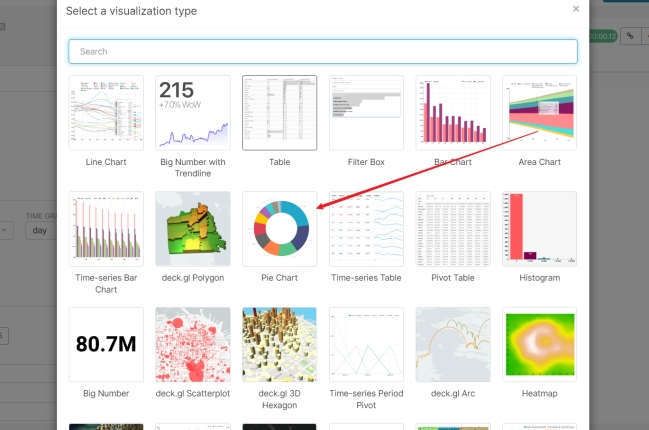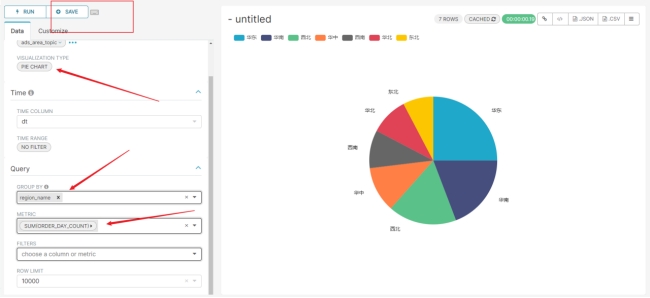1.用户行为数据采集;
(1).大数据集群的搭建:hadoop、zookeeper、kafka、hbase;
(2).模拟数据上传;



(3).修改配置文件application.properties、logback.xml;
# (数仓4.0为yml文件)
vim application.properties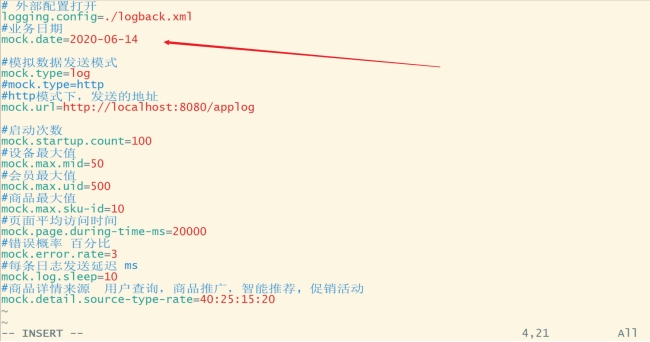
vim logback.xml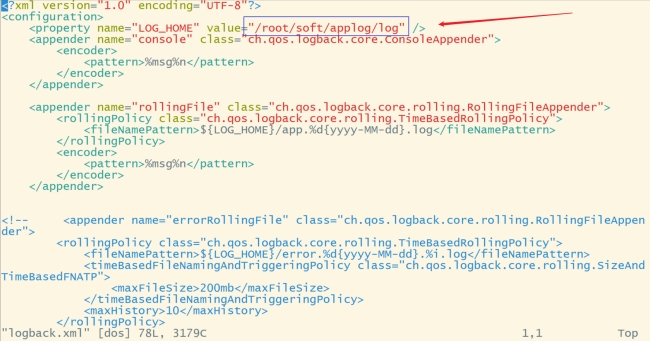
(4).生成日志并查看日志;
java -jar gmall2020-mock-log-2020-05-10.jar
# 进入log文件夹
cd log
# 查看
ll
(4).分发applog;
# 进入applog所在目录
cd /root/soft
# 分发
xsync applog(5).编写集群日志生成脚本;
echo $PATH
vim lg.sh
#!/bin/bash
for i in hadoop1 hadoop2; do
echo "========== $i =========="
ssh $i "cd /root/soft/applog; java -jar gmall2020-mock-log-2020-05-10.jar >/dev/null 2>&1 &"
done
为脚本赋执行权限并启动脚本:chmod u+x lg.sh

查看hadoop2的log文件是否生成日志:cd /root/soft/applog/log

(6).数据采集模块;
编写集群所有进程查看脚本并赋权限:
cd /root/bin
vim xcall.sh
chmod 777 xcall.sh
脚本内容:
#! /bin/bash
for i in hadoop1 hadoop2 hadoop3
do
echo --------- $i ----------
ssh $i "$*"
done
启动脚本:xcall.sh jps

(7).LZO压缩配置;
#下载wget:
yum -y install wget
#下载gcc-c++、zlib-devel、autoconf、automake、libtool:
yum -y install gcc-c++ lzo-devel zlib-devel autoconf automake libtool
#下载、安装并编译LZO:
wget http://www.oberhumer.com/opensource/lzo/download/lzo-2.10.tar.gz
#解压:
tar -zxvf lzo-2.10.tar.gz -C /root/soft
切换lzo目录并运行以下命令: cd /root/soft/lzo-2.10/
./configure -prefix=/root/soft/hadoop/lzo/
make
make install声明两个临时变量并使环境变量生效:vim ~/.bashrc source ~/.bashrc
export C_INCLUDE_PATH=/usr/local/hadoop/lzo/include
export LIBRARY_PATH=/usr/local/hadoop/lzo/lib 
上传hadoop-lzo-0.4.20.jar并放入hadoop下的common:
mv hadoop-lzo-0.4.20.jar /root/soft/hadoop/share/hadoop/common
#切换到common目录:
cd /root/soft/hadoop/share/hadoop/common
#分发hadoop-lzo-0.4.20.jar:
xsync hadoop-lzo-0.4.20.jar
#切换到core-site.xml增加支持LZO配置:
cd /root/soft/hadoop/etc/hadoop/编辑core-site.xml:vim core-site.xml
<property>
<name>io.compression.codecs</name>
<value>
org.apache.hadoop.io.compress.GzipCodec,
org.apache.hadoop.io.compress.DefaultCodec,
org.apache.hadoop.io.compress.BZip2Codec,
org.apache.hadoop.io.compress.SnappyCodec,
com.hadoop.compression.lzo.LzoCodec,
com.hadoop.compression.lzo.LzopCodec
</value>
</property>
<property>
<name>io.compression.codec.lzo.class</name>
<value>com.hadoop.compression.lzo.LzoCodec</value>
</property>
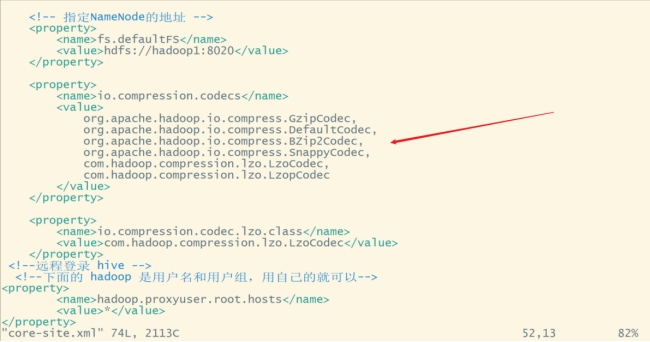
#分发core-site.xml:
xsync core-site.xml
#编写hadoop群起脚本:
cd /root/binvim hdp.sh
#!/bin/bash
if [ $# -lt 1 ]
then
echo "No Args Input..."
exit ;
fi
case $1 in
"start")
echo " =================== 启动 hadoop集群 ==================="
echo " --------------- 启动 hdfs ---------------"
ssh hadoop1 "/root/soft/hadoop/sbin/start-dfs.sh"
echo " --------------- 启动 yarn ---------------"
ssh hadoop2 "/root/soft/hadoop/sbin/start-yarn.sh"
echo " --------------- 启动 historyserver ---------------"
ssh hadoop1 "/root/soft/hadoop/bin/mapred --daemon start historyserver"
;;
"stop")
echo " =================== 关闭 hadoop集群 ==================="
echo " --------------- 关闭 historyserver ---------------"
ssh hadoop1 "/root/soft/hadoop/bin/mapred --daemon stop historyserver"
echo " --------------- 关闭 yarn ---------------"
ssh hadoop2 "/root/soft/hadoop/sbin/stop-yarn.sh"
echo " --------------- 关闭 hdfs ---------------"
ssh hadoop1 "/root/soft/hadoop/sbin/stop-dfs.sh"
;;
*)
echo "Input Args Error..."
;;
esac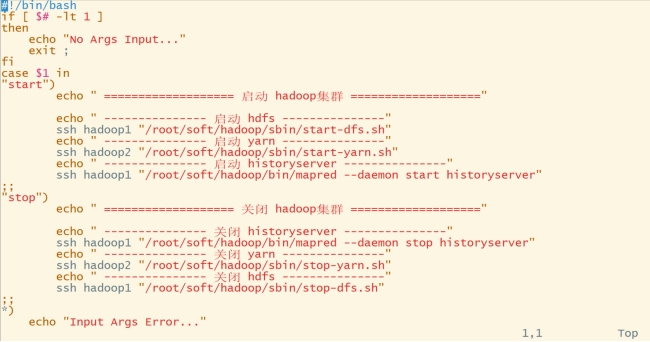
#赋权限:
chmod 777 hdp.sh
#启动集群:
hdp.sh start
#查看进程是否缺少:
xcall.sh jps(8).LZO创建索引;
上传bigtable.lzo到hdfs:
hdfs dfs -put bigtable.lzo /input
执行wordcount程序(如果执行不成功,hadoop配置就有问题,请重新配置):
hadoop jar /root/soft/hadoop/share/hadoop/mapreduce/hadoop-mapreduce-examples-3.1.3.jar wordcount -Dmapreduce.job.inputformat.class=com.hadoop.mapreduce.LzoTextInputFormat /input /output1
执行成功后查看output1中是否有文件(没有文件就是执行失败):
hdfs dfs -ls /output1对bigtable.lzo文件索引:
hadoop jar /root/soft/hadoop/share/hadoop/common/hadoop-lzo-0.4.20.jar com.hadoop.compression.lzo.DistributedLzoIndexer /input/bigtable.lzo再次执行wordcount:
hadoop jar /root/soft/hadoop/share/hadoop/mapreduce/hadoop-mapreduce-examples-3.1.3.jar wordcount -Dmapreduce.job.inputformat.class=com.hadoop.mapreduce.LzoTextInputFormat /input /output2
(9).日志采集Flume安装配置;
上传flume安装包并解压:
tar -zxvf apache-flume-1.9.0-bin.tar.gz -C /root/soft
切换到soft目录并重命名flume:cd /root/soft
mv apache-flume-1.9.0-bin flume最好不要使用软连接,后面使用flume可能会报如下图错误:
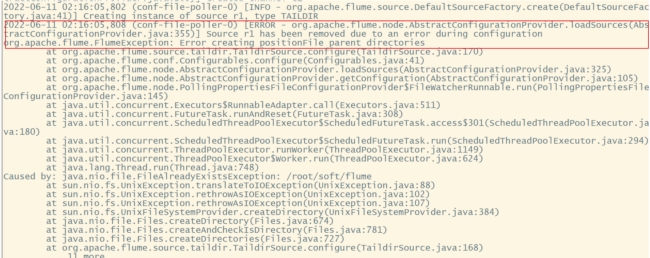
删除flume的lib下的guava-11.0.2.jar:
cd flume/lib
rm guava-11.0.2.jar切换到conf目录:cd ..
修改flume-env.sh.template名为flume-env.sh并配置:
mv flume-env.sh.template flume-env.sh
vim flume-env.sh
export JAVA_HOME=/root/soft/jdk(10).配置采集日志的conf文件;
#切换到flume下的conf:
cd /root/soft/flume/conf
#创建file-flume-kafka.conf:
vim file-flume-kafka.conf#为各组件命名
a1.sources = r1
a1.channels = c1
#描述source
a1.sources.r1.type = TAILDIR
a1.sources.r1.filegroups = f1
a1.sources.r1.filegroups.f1 = /root/soft/applog/log/app.*
a1.sources.r1.positionFile = /root/soft/flume/taildir_position.json
a1.sources.r1.interceptors = i1
a1.sources.r1.interceptors.i1.type = com.atguigu.flume.interceptor.ETLInterceptor$Builder
#描述channel
a1.channels.c1.type = org.apache.flume.channel.kafka.KafkaChannel
a1.channels.c1.kafka.bootstrap.servers = hadoop1:9092,hadoop2:9092
a1.channels.c1.kafka.topic = topic_log
a1.channels.c1.parseAsFlumeEvent = false
#绑定source和channel以及sink和channel的关系
a1.sources.r1.channels = c1
a1.sinks.k1.channel = c1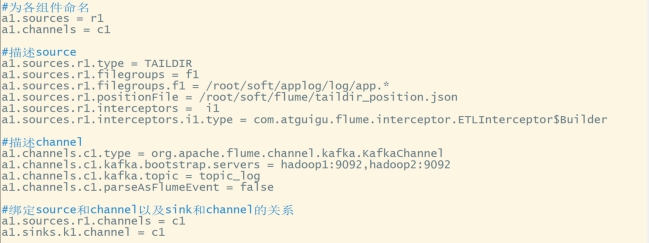
编写flume拦截器(展示部分代码):
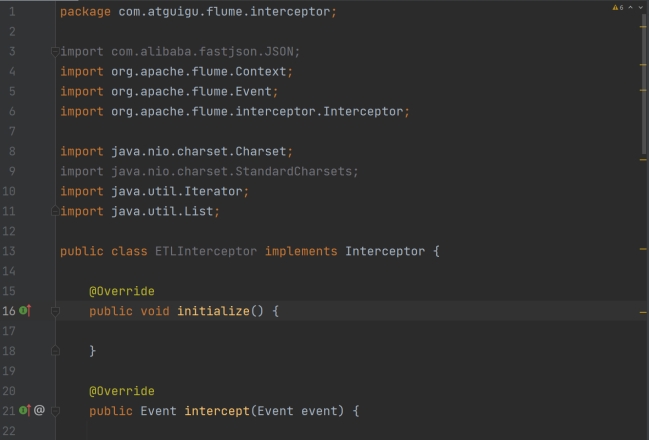
打jar包:

上传至flume的lib目录:

#切换到soft目录:
cd /root/soft
#分发flume:
xsync flume
#启动zookeeper和kafka:
zk.sh
kf.sh
#在hadoop1和hadoop2上启动flume:
#切换到flume目录:
cd /root/soft/flume
# 启动
bin/flume-ng agent --name a1 --conf-file conf/file-flume-kafka.conf &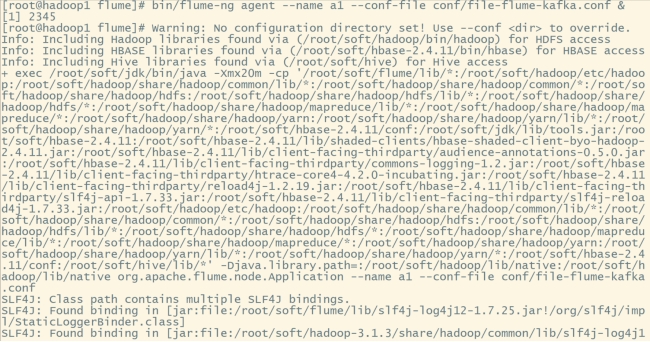
在hadoop3上的kafka中查看是否有数据存在,切换到kafka目录下:
bin/kafka-console-consumer.sh --bootstrap-server hadoop1:9092 --topic topic_log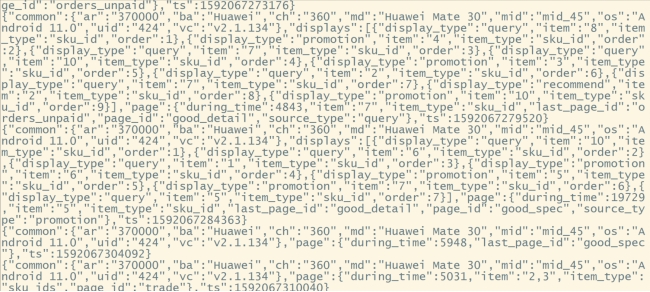
编写日志采集flume启停脚本:cd /root/bin
vim f1.sh
#! /bin/bash
case $1 in
"start"){
for i in hadoop1 hadoop2
do
echo " --------启动 $i 采集flume-------"
ssh $i "nohup /root/soft/flume/bin/flume-ng agent --conf-file /root/soft/flume/conf/file-flume-kafka.conf --name a1 -Dflume.root.logger=INFO,LOGFILE >/root/soft/flume/log1.txt 2>&1 &"
done
};;
"stop"){
for i in hadoop1 hadoop2
do
echo " --------停止 $i 采集flume-------"
ssh $i "ps -ef | grep file-flume-kafka | grep -v grep |awk '{print \$2}' | xargs -n1 kill -9 "
done
};;
esac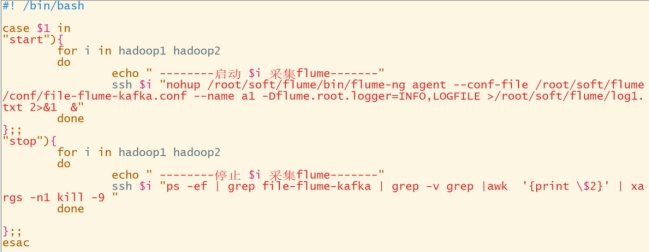
#赋权限:
chmod 777 f1.sh
#在hadoop3上flume的conf目录创建
vim kafka-flume-hdfs.conf
# 进入conf文件夹
cd /root/soft/flume/conf
#创建kafka-flume-hdfs.conf
vim kafka-flume-hdfs.conf# 组件
a1.sources=r1
a1.channels=c1
a1.sinks=k1
# source1
a1.sources.r1.type = org.apache.flume.source.kafka.KafkaSource
a1.sources.r1.batchSize = 5000
a1.sources.r1.batchDurationMillis = 2000
a1.sources.r1.kafka.bootstrap.servers = hadoop1:9092,hadoop2:9092,hadoop3:9092
a1.sources.r1.kafka.topics=topic_log
a1.sources.r1.interceptors = i1
a1.sources.r1.interceptors.i1.type = com.atguigu.flume.interceptor.TimeStampInterceptor$Builder
# channel1
a1.channels.c1.type = file
a1.channels.c1.checkpointDir = /root/soft/flume/checkpoint/behavior1
a1.channels.c1.dataDirs = /root/soft/flume/data/behavior1/
a1.channels.c1.maxFileSize = 2146435071
a1.channels.c1.capacity = 1000000
a1.channels.c1.keep-alive = 6
# sink1
a1.sinks.k1.type = hdfs
a1.sinks.k1.hdfs.path = /origin_data/gmall/log/topic_log/%Y-%m-%d
a1.sinks.k1.hdfs.filePrefix = log-
a1.sinks.k1.hdfs.round = false
a1.sinks.k1.hdfs.rollInterval = 10
a1.sinks.k1.hdfs.rollSize = 134217728
a1.sinks.k1.hdfs.rollCount = 0
# 控制输出文件是原生文件。
a1.sinks.k1.hdfs.fileType = CompressedStream
a1.sinks.k1.hdfs.codeC = lzop
# 拼装
a1.sources.r1.channels = c1
a1.sinks.k1.channel= c1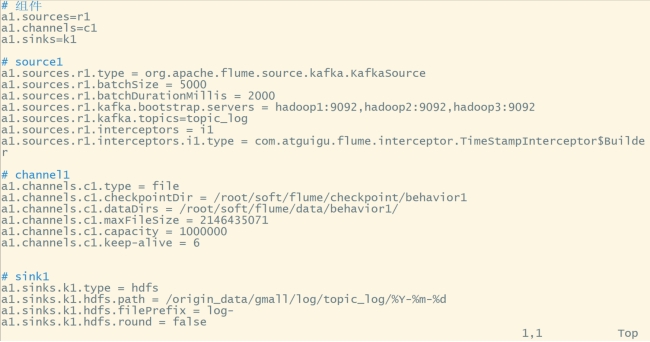
编写日志消费flume启停脚本:vim f2.sh
#! /bin/bash
case $1 in
"start"){
for i in hadoop3
do
echo " --------启动 $i 消费flume-------"
ssh $i "nohup /root/soft/flume/bin/flume-ng agent --conf-file /root/soft/flume/conf/kafka-flume-hdfs.conf --name a1 -Dflume.root.logger=INFO,LOGFILE >/root/soft/flume/log2.txt 2>&1 &"
done
};;
"stop"){
for i in hadoop3
do
echo " --------停止 $i 消费flume-------"
ssh $i "ps -ef | grep kafka-flume-hdfs | grep -v grep |awk '{print \$2}' | xargs -n1 kill"
done
};;
esac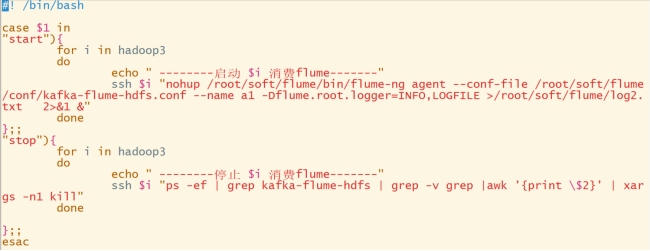
#赋权限:
chmod 777 f2.sh编写通道启脚本:
vim cluster.sh
#!/bin/bash
case $1 in
"start"){
echo ================== 启动 集群 ==================
#启动 Zookeeper集群
zk.sh start
#启动 Hadoop集群
hdp.sh start
#启动 Kafka采集集群
kf.sh start
#启动 Flume采集集群
f1.sh start
#启动 Flume消费集群
f2.sh start
};;
"stop"){
echo ================== 停止 集群 ==================
#停止 Flume消费集群
f2.sh stop
#停止 Flume采集集群
f1.sh stop
#停止 Kafka采集集群
kf.sh stop
#停止 Hadoop集群
hdp.sh stop
#停止 Zookeeper集群
zk.sh stop
};;
esac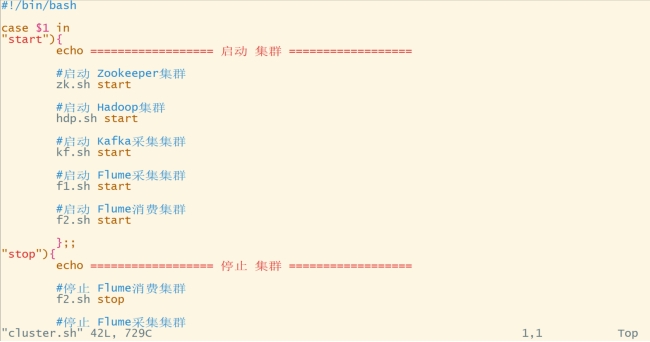

#赋权限:
chmod 777 cluster.sh
#启动日志采集通道:
cluster.sh start
#执行lg.sh:
lg.sh查看网页端是否有数据存在:hadoop1:9870
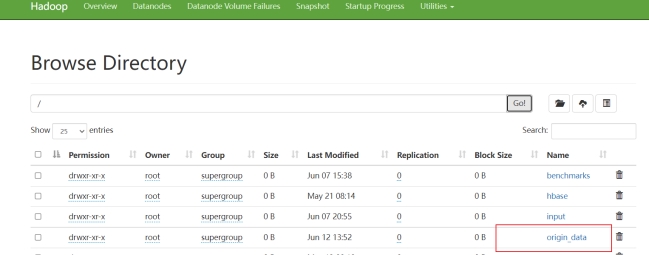
切换到applog修改application.properties中的业务日期为15:
cd /root/soft/applog/
vim application.properties
执行lg.sh:lg.sh
观察网页端是否有数据存在:

2.业务数据采集平台;
(1).安装mysql(参考如下网址);
(2).连接navicat并创建gmall数据库:
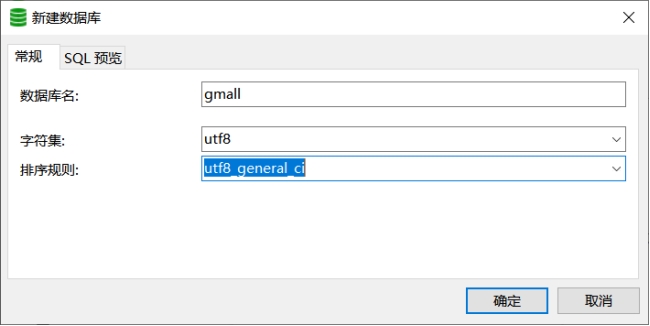
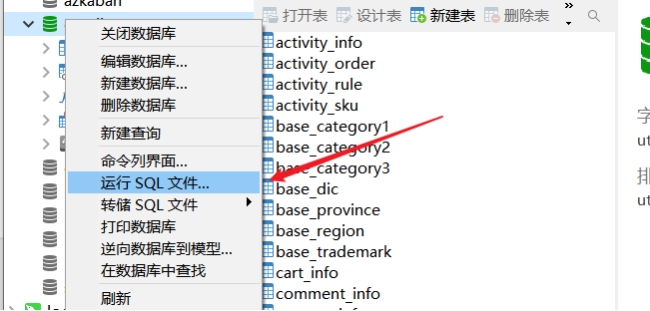

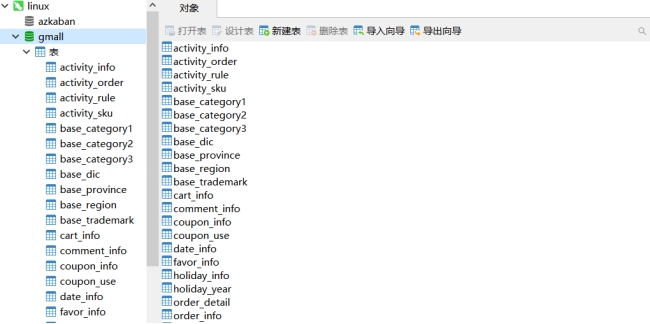
生成业务数据,在soft目录下创建db_log目录;
mkdir /root/soft/db_log上传gmall2020-mock-db-2020-05-18.jar、application.properties到db_log;

修改application.properties配置:vim application.properties

mock.date=2020-06-14
mock.clear=1执行命令生成2020-06-14日期数据:
java -jar gmall2020-mock-db-2020-05-18.jar 修改application.properties配置文件,重新执行命令生成2020-06-15日期数据:
mock.date=2020-06-15
mock.clear=0
java -jar gmall2020-mock-db-2020-05-18.jar (3).sqoop安装;
上传sqoop安装包并解压:

tar -zxvf sqoop-1.4.7.bin__hadoop-2.6.0.tar.gz -C /root/soft
#创建软连接:
ln -s sqoop-1.4.7.bin__hadoop-2.6.0 sqoop进入sqoop/conf目录,重命名sqoop-env-template.sh为sqoop-env.sh
mv sqoop-env-template.sh sqoop-env.sh并修改配置文件:cd /root/soft/sqoop/conf
vim sqoop-env.sh修改:
export HADOOP_COMMON_HOME=/root/soft/hadoop
export HADOOP_MAPRED_HOME=/root/soft/hadoop
export HIVE_HOME=/root/soft/hive
export ZOOKEEPER_HOME=/root/soft/zookeeper
export ZOOCFGDIR=/root/soft/zookeeper/conf
拷贝JDBC驱动,上传驱动并拷贝到sqoop的lib下:
cp mysql-connector-java-5.1.46.jar /root/soft/sqoop/lib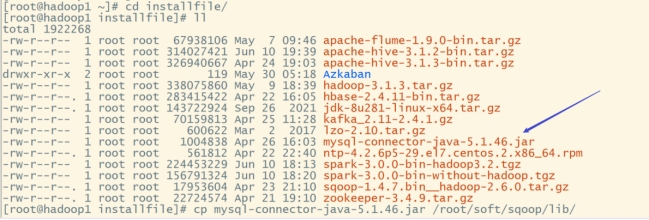
#验证sqoop,进入到sqoop目录:
cd /root/soft/sqoop
#执行sqoop命令:
bin/sqoop help
#测试sqoop是否能够成功连接数据库:
bin/sqoop list-databases --connect jdbc:mysql://hadoop1:3306/ --username root --password 123456
(4).业务数据导入HDFS;
在root/bin下编写mysql_to_hdfs.sh脚本(展示部分需要修改的代码):vim mysql_to_hdfs.sh
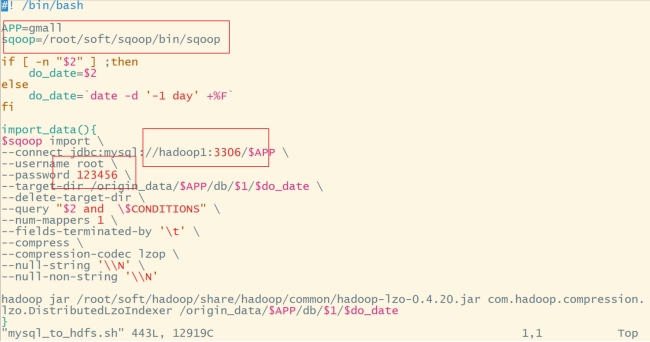
#赋权限:
chmod 777 mysql_to_hdfs.sh
#初次导入:
mysql_to_hdfs.sh first 2020-06-14
#每日导入:
mysql_to_hdfs.sh all 2020-06-15(5).安装hive(只能安装尚硅谷提供的hive-3.1.2);
上传jar包,并解压:
tar -zxvf apache-hive-3.1.2-bin.tar.gz -C /root/soft
# 进入soft目录
cd /root/soft
#创建软连接:
ln -s apache-hive-3.1.2-bin hive添加环境变量hive、spark:vim ~/.bashrc
export HIVE_HOME=~/soft/hive
export PATH=$HIVE_HOME/bin:$PATH
export SPARK_HOME=/root/soft/spark
export PATH=$PATH:$SPARK_HOME/bin
export PATH=$PATH:$SPARK_HOME/sbin
使环境变量生效:source ~/.bashrc
解决/root/soft/hive/lib下的日志jar包冲突:
mv log4j-slf4j-impl-2.10.0.jar log4j-slf4j-impl-2.10.0.jar.bak拷贝mysql驱动到/root/soft/hive/lib目录下:
cp mysql-connector-java-5.1.46.jar /root/soft/hive/lib配置Metastore到mysql,在/root/soft/hive/conf目录下创建hive-site.xml,添加如下内容(截取部分代码):
<?xml version="1.0" encoding="UTF-8" standalone="no"?>
<?xml-stylesheet type="text/xsl" href="configuration.xsl"?>
<configuration>
<property>
<name>javax.jdo.option.ConnectionURL</name>
<value>jdbc:mysql://hadoop1:3306/metastore?useSSL=false</value>
</property>
<property>
<name>javax.jdo.option.ConnectionDriverName</name>
<value>com.mysql.jdbc.Driver</value>
</property>
<property>
<name>javax.jdo.option.ConnectionUserName</name>
<value>root</value>
</property>
<property>
<name>javax.jdo.option.ConnectionPassword</name>
<value>123456</value>
</property>
<property>
<name>hive.metastore.warehouse.dir</name>
<value>/root/soft/hive/warehouse</value>
</property>
<property>
<name>hive.metastore.schema.verification</name>
<value>false</value>
</property>
<property>
<name>hive.server2.thrift.port</name>
<value>10000</value>
</property>
<property>
<name>hive.server2.thrift.bind.host</name>
<value>hadoop1</value>
</property>
<property>
<name>hive.metastore.event.db.notification.api.auth</name>
<value>false</value>
</property>
<property>
<name>hive.cli.print.header</name>
<value>true</value>
</property>
<property>
<name>hive.cli.print.current.db</name>
<value>true</value>
</property>
<!--Spark依赖位置(注意:端口号8020必须和namenode的端口号一致)-->
<property>
<name>spark.yarn.jars</name>
<value>hdfs://hadoop1:8020/spark-jars/*</value>
</property>
<!--Hive执行引擎-->
<property>
<name>hive.execution.engine</name>
<value>spark</value>
</property>
<!--Hive和Spark连接超时时间-->
<property>
<name>hive.spark.client.connect.timeout</name>
<value>10000ms</value>
</property>
</configuration>
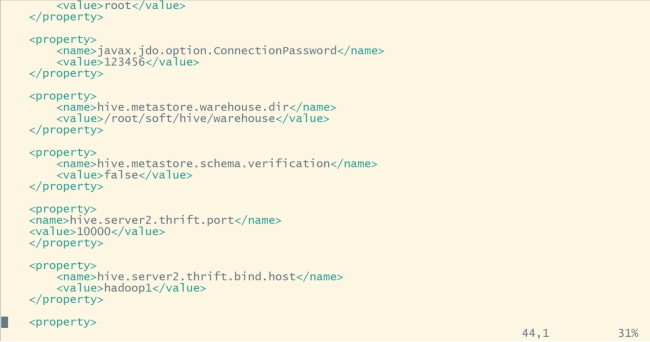
初始化元数据库,创建mysql数据库metastore:
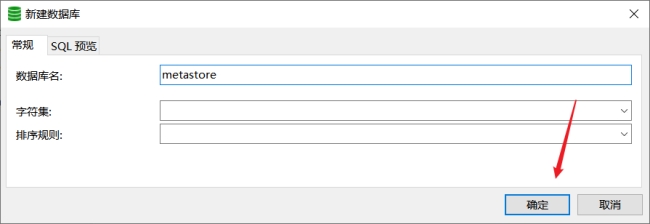
初始化命令: schematool -initSchema -dbType mysql -verbose
启动hive客户端:hive
查看数据库:show databases;

(6)配置Yarn容量调度器多队列
1,修改容量调度器配置文件
默认Yarn的配置下,容量调度器只有一条default队列。在capacity-scheduler.xml中可以配置多条队列,\修改**以下属性,增加hive队列。
<property>
<name>yarn.scheduler.capacity.root.queues</name>
<value>default,hive</value>
<description>
再增加一个hive队列
</description>
</property>
<property>
<name>yarn.scheduler.capacity.root.default.capacity</name>
<value>50</value>
<description>
default队列的容量为50%
</description>
</property>同时为新加队列\添加**必要属性:
<property>
<name>yarn.scheduler.capacity.root.hive.capacity</name>
<value>50</value>
<description>
hive队列的容量为50%
</description>
</property>
<property>
<name>yarn.scheduler.capacity.root.hive.user-limit-factor</name>
<value>1</value>
<description>
一个用户最多能够获取该队列资源容量的比例,取值0-1
</description>
</property>
<property>
<name>yarn.scheduler.capacity.root.hive.maximum-capacity</name>
<value>80</value>
<description>
hive队列的最大容量(自己队列资源不够,可以使用其他队列资源上限)
</description>
</property>
<property>
<name>yarn.scheduler.capacity.root.hive.state</name>
<value>RUNNING</value>
<description>
开启hive队列运行,不设置队列不能使用
</description>
</property>
<property>
<name>yarn.scheduler.capacity.root.hive.acl_submit_applications</name>
<value>*</value>
<description>
访问控制,控制谁可以将任务提交到该队列,*表示任何人
</description>
</property>
<property>
<name>yarn.scheduler.capacity.root.hive.acl_administer_queue</name>
<value>*</value>
<description>
访问控制,控制谁可以管理(包括提交和取消)该队列的任务,*表示任何人
</description>
</property>
<property>
<name>yarn.scheduler.capacity.root.hive.acl_application_max_priority</name>
<value>*</value>
<description>
指定哪个用户可以提交配置任务优先级
</description>
</property>
<property>
<name>yarn.scheduler.capacity.root.hive.maximum-application-lifetime</name>
<value>-1</value>
<description>
hive队列中任务的最大生命时长,以秒为单位。任何小于或等于零的值将被视为禁用。
</description>
</property>
<property>
<name>yarn.scheduler.capacity.root.hive.default-application-lifetime</name>
<value>-1</value>
<description>
hive队列中任务的默认生命时长,以秒为单位。任何小于或等于零的值将被视为禁用。
</description>
</property>2、分发配置文件
xsync /root/soft/hadoop/etc/hadoop/capacity-scheduler.xml3.数据仓库系统;
(1).部署hive on spark;


上传spark安装包(必须使用尚硅谷提供的安装包一个包为纯净版)并解压:

tar -zxvf spark-3.0.0-bin-hadoop3.2.tgz -C /root/soft
tar -zxvf spark-3.0.0-bin-without-hadoop.tgz -C /root/soft
# 进入soft目录
cd /root/soft
#创建软连接:
ln -s spark-3.0.0-bin-hadoop3.2 spark在hive中创建spark配置文件:
vim /root/soft/hive/conf/spark-defaults.conf
spark.master yarn
spark.eventLog.enabled true
spark.eventLog.dir hdfs://hadoop1:8020/spark-history
spark.executor.memory 1g
spark.driver.memory 1g
在HDFS创建如下路径:
hdfs dfs -mkdir /spark-history
hdfs dfs -mkdir /spark-jars上传spark纯净版jar包到hdfs
hdfs dfs -put /root/soft/spark-3.0.0-bin-without-hadoop/jars/* /spark-jars运行hive on spark之前需要更改,否则会报以下错误:
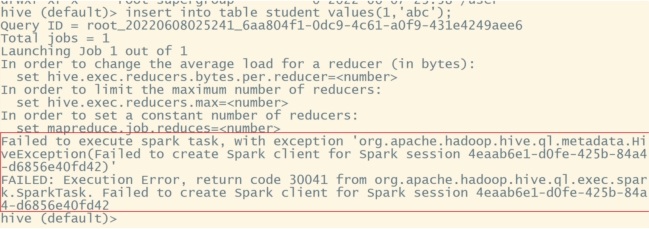
在/root/soft/hadoop/etc/hadoop/yarn-site.xml中配置:
<property>
<name>yarn.nodemanager.pmem-check-enabled</name>
<value>false</value>
</property>
<property>
<name>yarn.nodemanager.vmem-check-enabled</name>
<value>false</value>
</property>
同步到hadoop2、hadoop3:
xsync yarn-site.xml进入/root/soft/spark/conf
将spark-env.sh.template 复制一份:
cp spark-env.sh.template spark-env.sh然后在spark-env.sh中配置:
export SPARK_DIST_CLASSPATH=$(hadoop classpath)
启动hive客户端,并进行hive on spark测试;
#启动hive客户端命令:
hive
#创建表:
create table student(id int, name string);
#插入数据:
insert into table student values(1,'abc');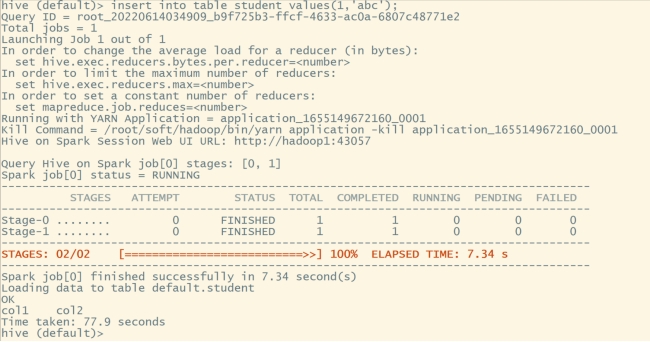
上图表示spark测试成功;
创建gmall数据库:create database gmall;
(2).启动hiveserver2,连接idea,
启动命令:hiveserver2
等待跑出4个session,连接idea:
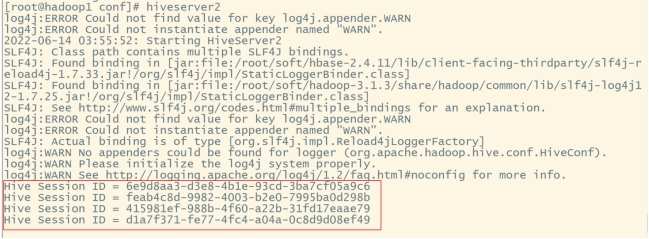

测试连接:
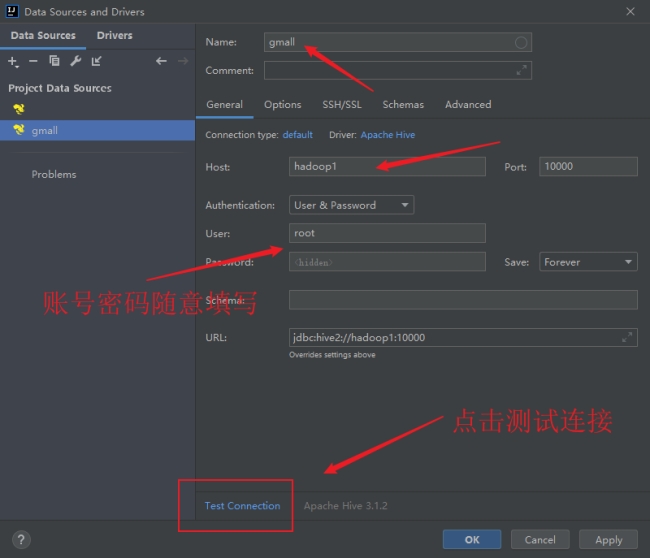

连接成功就可以使用了。
如果出现:
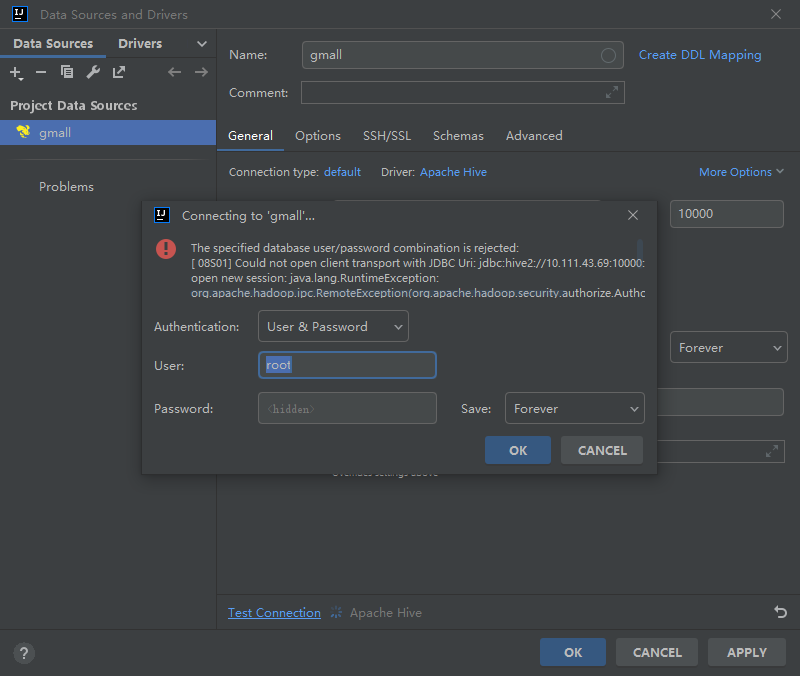
则需要:
修改 $HADOOP_HOME/etc/hadoop/core-site.xml 配置文件,添加如下配置:
<!--远程登录 hive -->
<!--下面的 hadoop 是用户名和用户组,用自己的就可以-->
<property>
<name>hadoop.proxyuser.root.hosts</name>
<value>*</value>
</property>
<property>
<name>hadoop.proxyuser.root.groups</name>
<value>*</value>
</property>分发core-site.xml
xsync /root/soft/hadoop/etc/hadoop/core-site.xml重启hadoop集群:hdp.sh stop
hdp.sh start重新测试连接
(3).创建UDTF函数;
创建一个maven工程:hivefunction
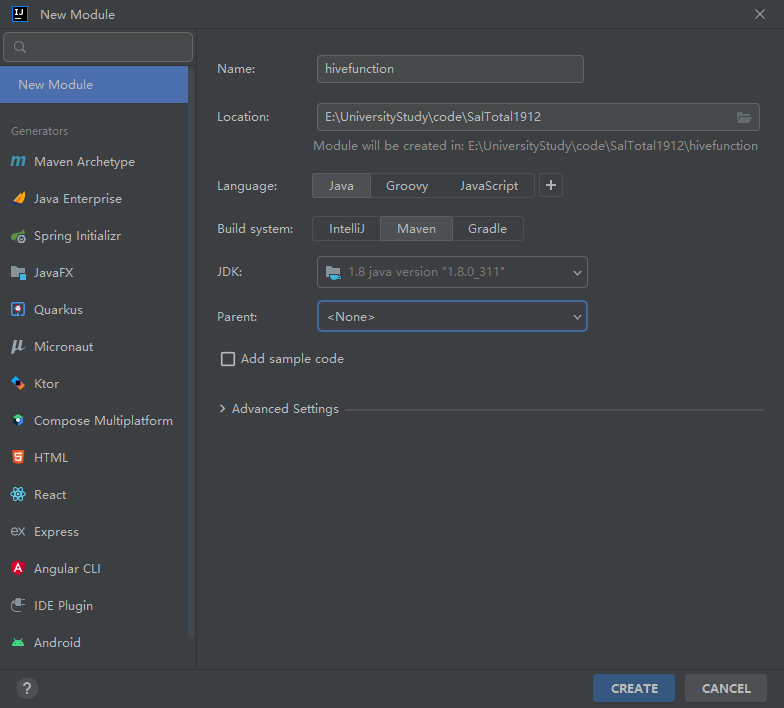
在pom.xml 添加hive依赖
<dependencies>
<!--添加hive依赖-->
<dependency>
<groupId>org.apache.hive</groupId>
<artifactId>hive-exec</artifactId>
<version>3.1.2</version>
</dependency>
</dependencies>创建ExplodeJSONArray类:
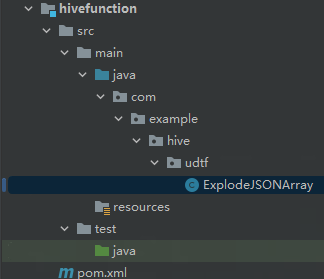
package com.example.hive.udtf;
import org.apache.hadoop.hive.ql.exec.UDFArgumentException;
import org.apache.hadoop.hive.ql.metadata.HiveException;
import org.apache.hadoop.hive.ql.udf.generic.GenericUDTF;
import org.apache.hadoop.hive.serde2.objectinspector.ObjectInspector;
import org.apache.hadoop.hive.serde2.objectinspector.ObjectInspectorFactory;
import org.apache.hadoop.hive.serde2.objectinspector.StructObjectInspector;
import org.apache.hadoop.hive.serde2.objectinspector.primitive.PrimitiveObjectInspectorFactory;
import org.json.JSONArray;
import java.util.ArrayList;
import java.util.List;
/**
* @author 成大事
* @since 2022/6/18 17:23
*/
public class ExplodeJSONArray extends GenericUDTF {
@Override
public StructObjectInspector initialize(StructObjectInspector argOIs) throws UDFArgumentException {
// 1 参数合法性检查
if (argOIs.getAllStructFieldRefs().size() != 1){
throw new UDFArgumentException("ExplodeJSONArray 只需要一个参数");
}
// 2 第一个参数必须为string
if(!"string".equals(argOIs.getAllStructFieldRefs().get(0).getFieldObjectInspector().getTypeName())){
throw new UDFArgumentException("json_array_to_struct_array的第1个参数应为string类型");
}
// 3 定义返回值名称和类型
List<String> fieldNames = new ArrayList<String>();
List<ObjectInspector> fieldOIs = new ArrayList<ObjectInspector>();
fieldNames.add("items");
fieldOIs.add(PrimitiveObjectInspectorFactory.javaStringObjectInspector);
return ObjectInspectorFactory.getStandardStructObjectInspector(fieldNames, fieldOIs);
}
public void process(Object[] objects) throws HiveException {
// 1 获取传入的数据
String jsonArray = objects[0].toString();
// 2 将string转换为json数组
JSONArray actions = new JSONArray(jsonArray);
// 3 循环一次,取出数组中的一个json,并写出
for (int i = 0; i < actions.length(); i++) {
String[] result = new String[1];
result[0] = actions.getString(i);
forward(result);
}
}
public void close() throws HiveException {
}
}在HDFS 创建/user/hive/jars 文件夹
hdfs dfs -mkdir -p /user/hive/jars打包上传到HDFS的/user/hive/jars路径下:
hdfs dfs -put hivefunction-1.0-SNAPSHOT.jar /user/hive/jars刚才idea已经连接了hive:
先使用use gmall :
然后在hive里面创建永久函数:
create function explode_json_array as 'com.example.hive.udtf.ExplodeJSONArray' using jar 'hdfs://hadoop1:8020/user/hive/jars/hivefunction-1.0-SNAPSHOT.jar';
(4).建ODS层(用户行为数据)表;
drop table if exists ods_log;
CREATE EXTERNAL TABLE ods_log (`line` string)
PARTITIONED BY (`dt` string) -- 按照时间创建分区
STORED AS -- 指定存储方式,读数据采用LzoTextInputFormat;
INPUTFORMAT 'com.hadoop.mapred.DeprecatedLzoTextInputFormat'
OUTPUTFORMAT 'org.apache.hadoop.hive.ql.io.HiveIgnoreKeyTextOutputFormat'
LOCATION '/warehouse/gmall/ods/ods_log' -- 指定数据在hdfs上的存储位置
;
-- 加载数据
load data inpath '/origin_data/gmall/log/topic_log/2020-06-14' into table ods_log partition(dt='2020-06-14');
-- 查看是否加载成功
select * from ods_log limit 2;在/root/bin下创建脚本:vim hdfs_to_ods_log.sh
#!/bin/bash
# 定义变量方便修改
APP=gmall
hive=/root/soft/hive/bin/hive
hadoop=/root/soft/hadoop/bin/hadoop
# 如果是输入的日期按照取输入日期;如果没输入日期取当前时间的前一天
if [ -n "$1" ] ;then
do_date=$1
else
do_date=`date -d "-1 day" +%F`
fi
echo ================== 日志日期为 $do_date ==================
sql="
load data inpath '/origin_data/$APP/log/topic_log/$do_date' into table ${APP}.ods_log partition(dt='$do_date');
"
$hive -e "$sql"
$hadoop jar /root/soft/hadoop/share/hadoop/common/hadoop-lzo-0.4.20.jar com.hadoop.compression.lzo.DistributedLzoIndexer -Dmapreduce.job.queuename=hive /warehouse/$APP/ods/ods_log/dt=$do_date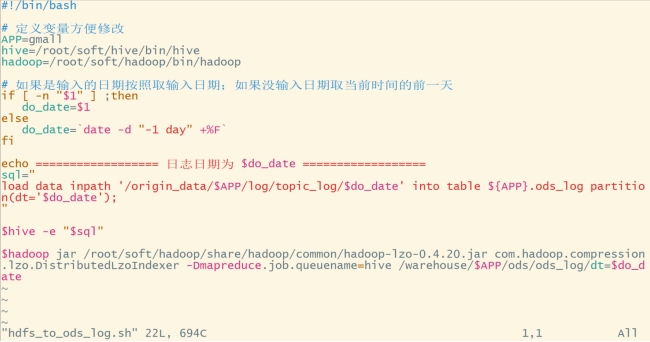
#赋权限:
chmod 777 hdfs_to_ods_log.sh
#使用脚本:
hdfs_to_ods_log.sh 2020-06-15查看数据:
select * from ods_log where dt='2020-06-15' limit 2;创建ODS层业务数据表,仅展示部分sql代码;


创建ODS数据加载脚本:vim hdfs_to_ods_db.sh
#!/bin/bash
APP=gmall
hive=/root/soft/hive/bin/hive
# 如果是输入的日期按照取输入日期;如果没输入日期取当前时间的前一天
if [ -n "$2" ] ;then
do_date=$2
else
do_date=`date -d "-1 day" +%F`
fi
sql1="
load data inpath '/origin_data/$APP/db/order_info/$do_date' OVERWRITE into table ${APP}.ods_order_info partition(dt='$do_date');
load data inpath '/origin_data/$APP/db/order_detail/$do_date' OVERWRITE into table ${APP}.ods_order_detail partition(dt='$do_date');
load data inpath '/origin_data/$APP/db/sku_info/$do_date' OVERWRITE into table ${APP}.ods_sku_info partition(dt='$do_date');
load data inpath '/origin_data/$APP/db/user_info/$do_date' OVERWRITE into table ${APP}.ods_user_info partition(dt='$do_date');
load data inpath '/origin_data/$APP/db/payment_info/$do_date' OVERWRITE into table ${APP}.ods_payment_info partition(dt='$do_date');
load data inpath '/origin_data/$APP/db/base_category1/$do_date' OVERWRITE into table ${APP}.ods_base_category1 partition(dt='$do_date');
load data inpath '/origin_data/$APP/db/base_category2/$do_date' OVERWRITE into table ${APP}.ods_base_category2 partition(dt='$do_date');
load data inpath '/origin_data/$APP/db/base_category3/$do_date' OVERWRITE into table ${APP}.ods_base_category3 partition(dt='$do_date');
load data inpath '/origin_data/$APP/db/base_trademark/$do_date' OVERWRITE into table ${APP}.ods_base_trademark partition(dt='$do_date');
load data inpath '/origin_data/$APP/db/activity_info/$do_date' OVERWRITE into table ${APP}.ods_activity_info partition(dt='$do_date');
load data inpath '/origin_data/$APP/db/activity_order/$do_date' OVERWRITE into table ${APP}.ods_activity_order partition(dt='$do_date');
load data inpath '/origin_data/$APP/db/cart_info/$do_date' OVERWRITE into table ${APP}.ods_cart_info partition(dt='$do_date');
load data inpath '/origin_data/$APP/db/comment_info/$do_date' OVERWRITE into table ${APP}.ods_comment_info partition(dt='$do_date');
load data inpath '/origin_data/$APP/db/coupon_info/$do_date' OVERWRITE into table ${APP}.ods_coupon_info partition(dt='$do_date');
load data inpath '/origin_data/$APP/db/coupon_use/$do_date' OVERWRITE into table ${APP}.ods_coupon_use partition(dt='$do_date');
load data inpath '/origin_data/$APP/db/favor_info/$do_date' OVERWRITE into table ${APP}.ods_favor_info partition(dt='$do_date');
load data inpath '/origin_data/$APP/db/order_refund_info/$do_date' OVERWRITE into table ${APP}.ods_order_refund_info partition(dt='$do_date');
load data inpath '/origin_data/$APP/db/order_status_log/$do_date' OVERWRITE into table ${APP}.ods_order_status_log partition(dt='$do_date');
load data inpath '/origin_data/$APP/db/spu_info/$do_date' OVERWRITE into table ${APP}.ods_spu_info partition(dt='$do_date');
load data inpath '/origin_data/$APP/db/activity_rule/$do_date' OVERWRITE into table ${APP}.ods_activity_rule partition(dt='$do_date');
load data inpath '/origin_data/$APP/db/base_dic/$do_date' OVERWRITE into table ${APP}.ods_base_dic partition(dt='$do_date');
"
sql2="
load data inpath '/origin_data/$APP/db/base_province/$do_date' OVERWRITE into table ${APP}.ods_base_province;
load data inpath '/origin_data/$APP/db/base_region/$do_date' OVERWRITE into table ${APP}.ods_base_region;
"
case $1 in
"first"){
$hive -e "$sql1$sql2"
};;
"all"){
$hive -e "$sql1"
};;
esac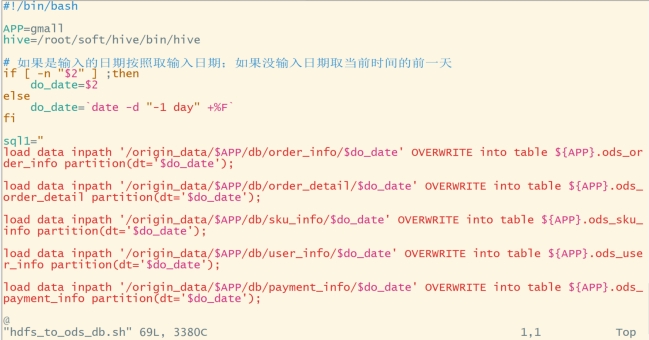
#赋权限:
chmod 777 hdfs_to_ods_db.sh
#运行脚本加载数据初次导入:
hdfs_to_ods_db.sh first 2020-06-14
#运行脚本加载数据每日导入:
hdfs_to_ods_db.sh all 2020-06-15测试是否成功导入数据:
select * from ods_order_detail where dt='2020-06-15';
(5).建DWD层(用户行为日志解析)表;
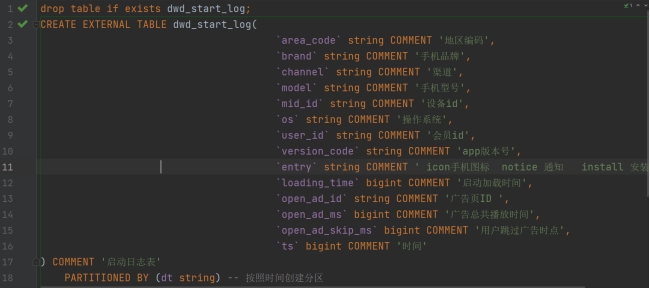
仅展示部分sql代码,创建加载数据脚本:vim ods_to_dwd_log.sh
#!/bin/bash
hive=/root/soft/hive/bin/hive
APP=gmall
# 如果是输入的日期按照取输入日期;如果没输入日期取当前时间的前一天
if [ -n "$1" ] ;then
do_date=$1
else
do_date=`date -d "-1 day" +%F`
fi
sql="
SET mapreduce.job.queuename=hive;
SET hive.input.format=org.apache.hadoop.hive.ql.io.HiveInputFormat;
insert overwrite table ${APP}.dwd_start_log partition(dt='$do_date')
select
get_json_object(line,'$.common.ar'),
get_json_object(line,'$.common.ba'),
get_json_object(line,'$.common.ch'),
get_json_object(line,'$.common.md'),
get_json_object(line,'$.common.mid'),
get_json_object(line,'$.common.os'),
get_json_object(line,'$.common.uid'),
get_json_object(line,'$.common.vc'),
get_json_object(line,'$.start.entry'),
get_json_object(line,'$.start.loading_time'),
get_json_object(line,'$.start.open_ad_id'),
get_json_object(line,'$.start.open_ad_ms'),
get_json_object(line,'$.start.open_ad_skip_ms'),
get_json_object(line,'$.ts')
from ${APP}.ods_log
where dt='$do_date'
and get_json_object(line,'$.start') is not null;
insert overwrite table ${APP}.dwd_action_log partition(dt='$do_date')
select
get_json_object(line,'$.common.ar'),
get_json_object(line,'$.common.ba'),
get_json_object(line,'$.common.ch'),
get_json_object(line,'$.common.md'),
get_json_object(line,'$.common.mid'),
get_json_object(line,'$.common.os'),
get_json_object(line,'$.common.uid'),
get_json_object(line,'$.common.vc'),
get_json_object(line,'$.page.during_time'),
get_json_object(line,'$.page.item'),
get_json_object(line,'$.page.item_type'),
get_json_object(line,'$.page.last_page_id'),
get_json_object(line,'$.page.page_id'),
get_json_object(line,'$.page.sourceType'),
get_json_object(action,'$.action_id'),
get_json_object(action,'$.item'),
get_json_object(action,'$.item_type'),
get_json_object(action,'$.ts')
from ${APP}.ods_log lateral view ${APP}.explode_json_array(get_json_object(line,'$.actions')) tmp as action
where dt='$do_date'
and get_json_object(line,'$.actions') is not null;
insert overwrite table ${APP}.dwd_display_log partition(dt='$do_date')
select
get_json_object(line,'$.common.ar'),
get_json_object(line,'$.common.ba'),
get_json_object(line,'$.common.ch'),
get_json_object(line,'$.common.md'),
get_json_object(line,'$.common.mid'),
get_json_object(line,'$.common.os'),
get_json_object(line,'$.common.uid'),
get_json_object(line,'$.common.vc'),
get_json_object(line,'$.page.during_time'),
get_json_object(line,'$.page.item'),
get_json_object(line,'$.page.item_type'),
get_json_object(line,'$.page.last_page_id'),
get_json_object(line,'$.page.page_id'),
get_json_object(line,'$.page.sourceType'),
get_json_object(line,'$.ts'),
get_json_object(display,'$.displayType'),
get_json_object(display,'$.item'),
get_json_object(display,'$.item_type'),
get_json_object(display,'$.order')
from ${APP}.ods_log lateral view ${APP}.explode_json_array(get_json_object(line,'$.displays')) tmp as display
where dt='$do_date'
and get_json_object(line,'$.displays') is not null;
insert overwrite table ${APP}.dwd_page_log partition(dt='$do_date')
select
get_json_object(line,'$.common.ar'),
get_json_object(line,'$.common.ba'),
get_json_object(line,'$.common.ch'),
get_json_object(line,'$.common.md'),
get_json_object(line,'$.common.mid'),
get_json_object(line,'$.common.os'),
get_json_object(line,'$.common.uid'),
get_json_object(line,'$.common.vc'),
get_json_object(line,'$.page.during_time'),
get_json_object(line,'$.page.item'),
get_json_object(line,'$.page.item_type'),
get_json_object(line,'$.page.last_page_id'),
get_json_object(line,'$.page.page_id'),
get_json_object(line,'$.page.sourceType'),
get_json_object(line,'$.ts')
from ${APP}.ods_log
where dt='$do_date'
and get_json_object(line,'$.page') is not null;
insert overwrite table ${APP}.dwd_error_log partition(dt='$do_date')
select
get_json_object(line,'$.common.ar'),
get_json_object(line,'$.common.ba'),
get_json_object(line,'$.common.ch'),
get_json_object(line,'$.common.md'),
get_json_object(line,'$.common.mid'),
get_json_object(line,'$.common.os'),
get_json_object(line,'$.common.uid'),
get_json_object(line,'$.common.vc'),
get_json_object(line,'$.page.item'),
get_json_object(line,'$.page.item_type'),
get_json_object(line,'$.page.last_page_id'),
get_json_object(line,'$.page.page_id'),
get_json_object(line,'$.page.sourceType'),
get_json_object(line,'$.start.entry'),
get_json_object(line,'$.start.loading_time'),
get_json_object(line,'$.start.open_ad_id'),
get_json_object(line,'$.start.open_ad_ms'),
get_json_object(line,'$.start.open_ad_skip_ms'),
get_json_object(line,'$.actions'),
get_json_object(line,'$.displays'),
get_json_object(line,'$.ts'),
get_json_object(line,'$.err.error_code'),
get_json_object(line,'$.err.msg')
from ${APP}.ods_log
where dt='$do_date'
and get_json_object(line,'$.err') is not null;
"
$hive -e "$sql"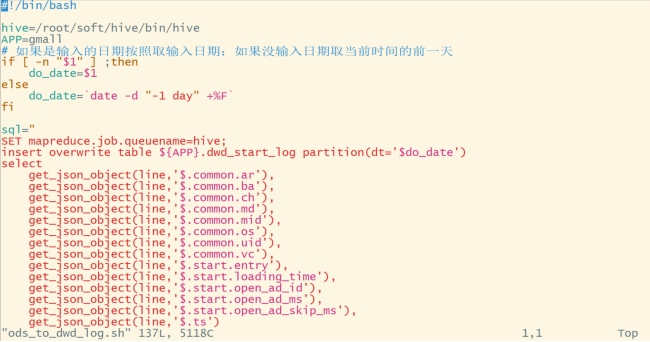
#赋权限:
chmod 777 ods_to_dwd_log.sh
#执行脚本加载数据:
ods_to_dwd_log.sh 2020-06-15查询导入结果:
select * from dwd_start_log where dt='2020-06-15' limit 2;DWD层业务数据表,仅展示部分sql代码;

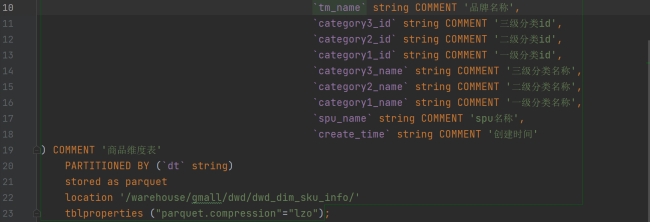
创建DWD数据加载脚本:vim ods_to_dwd_db.sh
#!/bin/bash
APP=gmall
hive=/root/soft/hive/bin/hive
# 如果是输入的日期按照取输入日期;如果没输入日期取当前时间的前一天
if [ -n "$2" ] ;then
do_date=$2
else
do_date=`date -d "-1 day" +%F`
fi
sql1="
set mapreduce.job.queuename=hive;
set hive.exec.dynamic.partition.mode=nonstrict;
insert overwrite table ${APP}.dwd_dim_sku_info partition(dt='$do_date')
select
sku.id,
sku.spu_id,
sku.price,
sku.sku_name,
sku.sku_desc,
sku.weight,
sku.tm_id,
ob.tm_name,
sku.category3_id,
c2.id category2_id,
c1.id category1_id,
c3.name category3_name,
c2.name category2_name,
c1.name category1_name,
spu.spu_name,
sku.create_time
from
(
select * from ${APP}.ods_sku_info where dt='$do_date'
)sku
join
(
select * from ${APP}.ods_base_trademark where dt='$do_date'
)ob on sku.tm_id=ob.tm_id
join
(
select * from ${APP}.ods_spu_info where dt='$do_date'
)spu on spu.id = sku.spu_id
join
(
select * from ${APP}.ods_base_category3 where dt='$do_date'
)c3 on sku.category3_id=c3.id
join
(
select * from ${APP}.ods_base_category2 where dt='$do_date'
)c2 on c3.category2_id=c2.id
join
(
select * from ${APP}.ods_base_category1 where dt='$do_date'
)c1 on c2.category1_id=c1.id;
insert overwrite table ${APP}.dwd_dim_coupon_info partition(dt='$do_date')
select
id,
coupon_name,
coupon_type,
condition_amount,
condition_num,
activity_id,
benefit_amount,
benefit_discount,
create_time,
range_type,
spu_id,
tm_id,
category3_id,
limit_num,
operate_time,
expire_time
from ${APP}.ods_coupon_info
where dt='$do_date';
insert overwrite table ${APP}.dwd_dim_activity_info partition(dt='$do_date')
select
id,
activity_name,
activity_type,
start_time,
end_time,
create_time
from ${APP}.ods_activity_info
where dt='$do_date';
insert overwrite table ${APP}.dwd_fact_order_detail partition(dt='$do_date')
select
id,
order_id,
user_id,
sku_id,
sku_num,
order_price,
sku_num,
create_time,
province_id,
source_type,
source_id,
original_amount_d,
if(rn=1,final_total_amount-(sum_div_final_amount-final_amount_d),final_amount_d),
if(rn=1,feight_fee-(sum_div_feight_fee-feight_fee_d),feight_fee_d),
if(rn=1,benefit_reduce_amount-(sum_div_benefit_reduce_amount-benefit_reduce_amount_d),benefit_reduce_amount_d)
from
(
select
od.id,
od.order_id,
od.user_id,
od.sku_id,
od.sku_name,
od.order_price,
od.sku_num,
od.create_time,
oi.province_id,
od.source_type,
od.source_id,
round(od.order_price*od.sku_num,2) original_amount_d,
round(od.order_price*od.sku_num/oi.original_total_amount*oi.final_total_amount,2) final_amount_d,
round(od.order_price*od.sku_num/oi.original_total_amount*oi.feight_fee,2) feight_fee_d,
round(od.order_price*od.sku_num/oi.original_total_amount*oi.benefit_reduce_amount,2) benefit_reduce_amount_d,
row_number() over(partition by od.order_id order by od.id desc) rn,
oi.final_total_amount,
oi.feight_fee,
oi.benefit_reduce_amount,
sum(round(od.order_price*od.sku_num/oi.original_total_amount*oi.final_total_amount,2)) over(partition by od.order_id) sum_div_final_amount,
sum(round(od.order_price*od.sku_num/oi.original_total_amount*oi.feight_fee,2)) over(partition by od.order_id) sum_div_feight_fee,
sum(round(od.order_price*od.sku_num/oi.original_total_amount*oi.benefit_reduce_amount,2)) over(partition by od.order_id) sum_div_benefit_reduce_amount
from
(
select * from ${APP}.ods_order_detail where dt='$do_date'
) od
join
(
select * from ${APP}.ods_order_info where dt='$do_date'
) oi
on od.order_id=oi.id
)t1;
insert overwrite table ${APP}.dwd_fact_payment_info partition(dt='$do_date')
select
pi.id,
pi.out_trade_no,
pi.order_id,
pi.user_id,
pi.alipay_trade_no,
pi.total_amount,
pi.subject,
pi.payment_type,
pi.payment_time,
oi.province_id
from
(
select * from ${APP}.ods_payment_info where dt='$do_date'
)pi
join
(
select id, province_id from ${APP}.ods_order_info where dt='$do_date'
)oi
on pi.order_id = oi.id;
insert overwrite table ${APP}.dwd_fact_order_refund_info partition(dt='$do_date')
select
id,
user_id,
order_id,
sku_id,
refund_type,
refund_num,
refund_amount,
refund_reason_type,
create_time
from ${APP}.ods_order_refund_info
where dt='$do_date';
insert overwrite table ${APP}.dwd_fact_comment_info partition(dt='$do_date')
select
id,
user_id,
sku_id,
spu_id,
order_id,
appraise,
create_time
from ${APP}.ods_comment_info
where dt='$do_date';
insert overwrite table ${APP}.dwd_fact_cart_info partition(dt='$do_date')
select
id,
user_id,
sku_id,
cart_price,
sku_num,
sku_name,
create_time,
operate_time,
is_ordered,
order_time,
source_type,
source_id
from ${APP}.ods_cart_info
where dt='$do_date';
insert overwrite table ${APP}.dwd_fact_favor_info partition(dt='$do_date')
select
id,
user_id,
sku_id,
spu_id,
is_cancel,
create_time,
cancel_time
from ${APP}.ods_favor_info
where dt='$do_date';
insert overwrite table ${APP}.dwd_fact_coupon_use partition(dt)
select
if(new.id is null,old.id,new.id),
if(new.coupon_id is null,old.coupon_id,new.coupon_id),
if(new.user_id is null,old.user_id,new.user_id),
if(new.order_id is null,old.order_id,new.order_id),
if(new.coupon_status is null,old.coupon_status,new.coupon_status),
if(new.get_time is null,old.get_time,new.get_time),
if(new.using_time is null,old.using_time,new.using_time),
if(new.used_time is null,old.used_time,new.used_time),
date_format(if(new.get_time is null,old.get_time,new.get_time),'yyyy-MM-dd')
from
(
select
id,
coupon_id,
user_id,
order_id,
coupon_status,
get_time,
using_time,
used_time
from ${APP}.dwd_fact_coupon_use
where dt in
(
select
date_format(get_time,'yyyy-MM-dd')
from ${APP}.ods_coupon_use
where dt='$do_date'
)
)old
full outer join
(
select
id,
coupon_id,
user_id,
order_id,
coupon_status,
get_time,
using_time,
used_time
from ${APP}.ods_coupon_use
where dt='$do_date'
)new
on old.id=new.id;
insert overwrite table ${APP}.dwd_fact_order_info partition(dt)
select
if(new.id is null,old.id,new.id),
if(new.order_status is null,old.order_status,new.order_status),
if(new.user_id is null,old.user_id,new.user_id),
if(new.out_trade_no is null,old.out_trade_no,new.out_trade_no),
if(new.tms['1001'] is null,old.create_time,new.tms['1001']),--1001对应未支付状态
if(new.tms['1002'] is null,old.payment_time,new.tms['1002']),
if(new.tms['1003'] is null,old.cancel_time,new.tms['1003']),
if(new.tms['1004'] is null,old.finish_time,new.tms['1004']),
if(new.tms['1005'] is null,old.refund_time,new.tms['1005']),
if(new.tms['1006'] is null,old.refund_finish_time,new.tms['1006']),
if(new.province_id is null,old.province_id,new.province_id),
if(new.activity_id is null,old.activity_id,new.activity_id),
if(new.original_total_amount is null,old.original_total_amount,new.original_total_amount),
if(new.benefit_reduce_amount is null,old.benefit_reduce_amount,new.benefit_reduce_amount),
if(new.feight_fee is null,old.feight_fee,new.feight_fee),
if(new.final_total_amount is null,old.final_total_amount,new.final_total_amount),
date_format(if(new.tms['1001'] is null,old.create_time,new.tms['1001']),'yyyy-MM-dd')
from
(
select
id,
order_status,
user_id,
out_trade_no,
create_time,
payment_time,
cancel_time,
finish_time,
refund_time,
refund_finish_time,
province_id,
activity_id,
original_total_amount,
benefit_reduce_amount,
feight_fee,
final_total_amount
from ${APP}.dwd_fact_order_info
where dt
in
(
select
date_format(create_time,'yyyy-MM-dd')
from ${APP}.ods_order_info
where dt='$do_date'
)
)old
full outer join
(
select
info.id,
info.order_status,
info.user_id,
info.out_trade_no,
info.province_id,
act.activity_id,
log.tms,
info.original_total_amount,
info.benefit_reduce_amount,
info.feight_fee,
info.final_total_amount
from
(
select
order_id,
str_to_map(concat_ws(',',collect_set(concat(order_status,'=',operate_time))),',','=') tms
from ${APP}.ods_order_status_log
where dt='$do_date'
group by order_id
)log
join
(
select * from ${APP}.ods_order_info where dt='$do_date'
)info
on log.order_id=info.id
left join
(
select * from ${APP}.ods_activity_order where dt='$do_date'
)act
on log.order_id=act.order_id
)new
on old.id=new.id;
"
sql2="
insert overwrite table ${APP}.dwd_dim_base_province
select
bp.id,
bp.name,
bp.area_code,
bp.iso_code,
bp.region_id,
br.region_name
from ${APP}.ods_base_province bp
join ${APP}.ods_base_region br
on bp.region_id=br.id;
"
sql3="
insert overwrite table ${APP}.dwd_dim_user_info_his_tmp
select * from
(
select
id,
name,
birthday,
gender,
email,
user_level,
create_time,
operate_time,
'$do_date' start_date,
'9999-99-99' end_date
from ${APP}.ods_user_info where dt='$do_date'
union all
select
uh.id,
uh.name,
uh.birthday,
uh.gender,
uh.email,
uh.user_level,
uh.create_time,
uh.operate_time,
uh.start_date,
if(ui.id is not null and uh.end_date='9999-99-99', date_add(ui.dt,-1), uh.end_date) end_date
from ${APP}.dwd_dim_user_info_his uh left join
(
select
*
from ${APP}.ods_user_info
where dt='$do_date'
) ui on uh.id=ui.id
)his
order by his.id, start_date;
insert overwrite table ${APP}.dwd_dim_user_info_his
select * from ${APP}.dwd_dim_user_info_his_tmp;
"
case $1 in
"first"){
$hive -e "$sql1$sql2"
};;
"all"){
$hive -e "$sql1$sql3"
};;
esac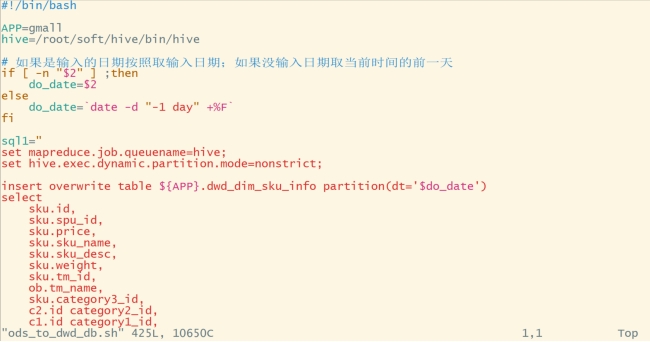
#赋权限:
chmod 777 ods_to_dwd_db.sh
#运行脚本加载数据初次导入:
ods_to_dwd_db.sh first 2020-06-14
#运行脚本加载数据每日导入:
ods_to_dwd_db.sh all 2020-06-15查看数据是否导入:
select id, start_date, end_date from dwd_dim_user_info_his limit 2;
(6).建DWS层所有主题对象当天的汇总行为表;
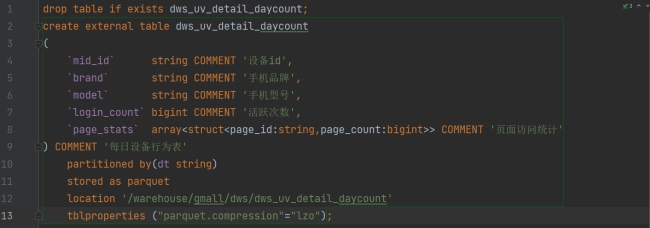
仅展示部分sql代码,创建DWS加载数据脚本:vim dwd_to_dws.sh
#!/bin/bash
APP=gmall
hive=/root/soft/hive/bin/hive
# 如果是输入的日期按照取输入日期;如果没输入日期取当前时间的前一天
if [ -n "$1" ] ;then
do_date=$1
else
do_date=`date -d "-1 day" +%F`
fi
sql="
set mapreduce.job.queuename=hive;
with
tmp_start as
(
select
mid_id,
brand,
model,
count(*) login_count
from ${APP}.dwd_start_log
where dt='$do_date'
group by mid_id,brand,model
),
tmp_page as
(
select
mid_id,
brand,
model,
collect_set(named_struct('page_id',page_id,'page_count',page_count)) page_stats
from
(
select
mid_id,
brand,
model,
page_id,
count(*) page_count
from ${APP}.dwd_page_log
where dt='$do_date'
group by mid_id,brand,model,page_id
)tmp
group by mid_id,brand,model
)
insert overwrite table ${APP}.dws_uv_detail_daycount partition(dt='$do_date')
select
nvl(tmp_start.mid_id,tmp_page.mid_id),
nvl(tmp_start.brand,tmp_page.brand),
nvl(tmp_start.model,tmp_page.model),
tmp_start.login_count,
tmp_page.page_stats
from tmp_start
full outer join tmp_page
on tmp_start.mid_id=tmp_page.mid_id
and tmp_start.brand=tmp_page.brand
and tmp_start.model=tmp_page.model;
with
tmp_login as
(
select
user_id,
count(*) login_count
from ${APP}.dwd_start_log
where dt='$do_date'
and user_id is not null
group by user_id
),
tmp_cart as
(
select
user_id,
count(*) cart_count
from ${APP}.dwd_action_log
where dt='$do_date'
and user_id is not null
and action_id='cart_add'
group by user_id
),tmp_order as
(
select
user_id,
count(*) order_count,
sum(final_total_amount) order_amount
from ${APP}.dwd_fact_order_info
where dt='$do_date'
group by user_id
) ,
tmp_payment as
(
select
user_id,
count(*) payment_count,
sum(payment_amount) payment_amount
from ${APP}.dwd_fact_payment_info
where dt='$do_date'
group by user_id
),
tmp_order_detail as
(
select
user_id,
collect_set(named_struct('sku_id',sku_id,'sku_num',sku_num,'order_count',order_count,'order_amount',order_amount)) order_stats
from
(
select
user_id,
sku_id,
sum(sku_num) sku_num,
count(*) order_count,
cast(sum(final_amount_d) as decimal(20,2)) order_amount
from ${APP}.dwd_fact_order_detail
where dt='$do_date'
group by user_id,sku_id
)tmp
group by user_id
)
insert overwrite table ${APP}.dws_user_action_daycount partition(dt='$do_date')
select
tmp_login.user_id,
login_count,
nvl(cart_count,0),
nvl(order_count,0),
nvl(order_amount,0.0),
nvl(payment_count,0),
nvl(payment_amount,0.0),
order_stats
from tmp_login
left outer join tmp_cart on tmp_login.user_id=tmp_cart.user_id
left outer join tmp_order on tmp_login.user_id=tmp_order.user_id
left outer join tmp_payment on tmp_login.user_id=tmp_payment.user_id
left outer join tmp_order_detail on tmp_login.user_id=tmp_order_detail.user_id;
with
tmp_order as
(
select
sku_id,
count(*) order_count,
sum(sku_num) order_num,
sum(final_amount_d) order_amount
from ${APP}.dwd_fact_order_detail
where dt='$do_date'
group by sku_id
),
tmp_payment as
(
select
sku_id,
count(*) payment_count,
sum(sku_num) payment_num,
sum(final_amount_d) payment_amount
from ${APP}.dwd_fact_order_detail
where (dt='$do_date'
or dt=date_add('$do_date',-1))
and order_id in
(
select
id
from ${APP}.dwd_fact_order_info
where (dt='$do_date'
or dt=date_add('$do_date',-1))
and date_format(payment_time,'yyyy-MM-dd')='$do_date'
)
group by sku_id
),
tmp_refund as
(
select
sku_id,
count(*) refund_count,
sum(refund_num) refund_num,
sum(refund_amount) refund_amount
from ${APP}.dwd_fact_order_refund_info
where dt='$do_date'
group by sku_id
),
tmp_cart as
(
select
item sku_id,
count(*) cart_count
from ${APP}.dwd_action_log
where dt='$do_date'
and user_id is not null
and action_id='cart_add'
group by item
),tmp_favor as
(
select
item sku_id,
count(*) favor_count
from ${APP}.dwd_action_log
where dt='$do_date'
and user_id is not null
and action_id='favor_add'
group by item
),
tmp_appraise as
(
select
sku_id,
sum(if(appraise='1201',1,0)) appraise_good_count,
sum(if(appraise='1202',1,0)) appraise_mid_count,
sum(if(appraise='1203',1,0)) appraise_bad_count,
sum(if(appraise='1204',1,0)) appraise_default_count
from ${APP}.dwd_fact_comment_info
where dt='$do_date'
group by sku_id
)
insert overwrite table ${APP}.dws_sku_action_daycount partition(dt='$do_date')
select
sku_id,
sum(order_count),
sum(order_num),
sum(order_amount),
sum(payment_count),
sum(payment_num),
sum(payment_amount),
sum(refund_count),
sum(refund_num),
sum(refund_amount),
sum(cart_count),
sum(favor_count),
sum(appraise_good_count),
sum(appraise_mid_count),
sum(appraise_bad_count),
sum(appraise_default_count)
from
(
select
sku_id,
order_count,
order_num,
order_amount,
0 payment_count,
0 payment_num,
0 payment_amount,
0 refund_count,
0 refund_num,
0 refund_amount,
0 cart_count,
0 favor_count,
0 appraise_good_count,
0 appraise_mid_count,
0 appraise_bad_count,
0 appraise_default_count
from tmp_order
union all
select
sku_id,
0 order_count,
0 order_num,
0 order_amount,
payment_count,
payment_num,
payment_amount,
0 refund_count,
0 refund_num,
0 refund_amount,
0 cart_count,
0 favor_count,
0 appraise_good_count,
0 appraise_mid_count,
0 appraise_bad_count,
0 appraise_default_count
from tmp_payment
union all
select
sku_id,
0 order_count,
0 order_num,
0 order_amount,
0 payment_count,
0 payment_num,
0 payment_amount,
refund_count,
refund_num,
refund_amount,
0 cart_count,
0 favor_count,
0 appraise_good_count,
0 appraise_mid_count,
0 appraise_bad_count,
0 appraise_default_count
from tmp_refund
union all
select
sku_id,
0 order_count,
0 order_num,
0 order_amount,
0 payment_count,
0 payment_num,
0 payment_amount,
0 refund_count,
0 refund_num,
0 refund_amount,
cart_count,
0 favor_count,
0 appraise_good_count,
0 appraise_mid_count,
0 appraise_bad_count,
0 appraise_default_count
from tmp_cart
union all
select
sku_id,
0 order_count,
0 order_num,
0 order_amount,
0 payment_count,
0 payment_num,
0 payment_amount,
0 refund_count,
0 refund_num,
0 refund_amount,
0 cart_count,
favor_count,
0 appraise_good_count,
0 appraise_mid_count,
0 appraise_bad_count,
0 appraise_default_count
from tmp_favor
union all
select
sku_id,
0 order_count,
0 order_num,
0 order_amount,
0 payment_count,
0 payment_num,
0 payment_amount,
0 refund_count,
0 refund_num,
0 refund_amount,
0 cart_count,
0 favor_count,
appraise_good_count,
appraise_mid_count,
appraise_bad_count,
appraise_default_count
from tmp_appraise
)tmp
group by sku_id;
with
tmp_login as
(
select
area_code,
count(*) login_count
from ${APP}.dwd_start_log
where dt='$do_date'
group by area_code
),
tmp_op as
(
select
province_id,
sum(if(date_format(create_time,'yyyy-MM-dd')='$do_date',1,0)) order_count,
sum(if(date_format(create_time,'yyyy-MM-dd')='$do_date',final_total_amount,0)) order_amount,
sum(if(date_format(payment_time,'yyyy-MM-dd')='$do_date',1,0)) payment_count,
sum(if(date_format(payment_time,'yyyy-MM-dd')='$do_date',final_total_amount,0)) payment_amount
from ${APP}.dwd_fact_order_info
where (dt='$do_date' or dt=date_add('$do_date',-1))
group by province_id
)
insert overwrite table ${APP}.dws_area_stats_daycount partition(dt='$do_date')
select
pro.id,
pro.province_name,
pro.area_code,
pro.iso_code,
pro.region_id,
pro.region_name,
nvl(tmp_login.login_count,0),
nvl(tmp_op.order_count,0),
nvl(tmp_op.order_amount,0.0),
nvl(tmp_op.payment_count,0),
nvl(tmp_op.payment_amount,0.0)
from ${APP}.dwd_dim_base_province pro
left join tmp_login on pro.area_code=tmp_login.area_code
left join tmp_op on pro.id=tmp_op.province_id;
with
tmp_op as
(
select
activity_id,
sum(if(date_format(create_time,'yyyy-MM-dd')='$do_date',1,0)) order_count,
sum(if(date_format(create_time,'yyyy-MM-dd')='$do_date',final_total_amount,0)) order_amount,
sum(if(date_format(payment_time,'yyyy-MM-dd')='$do_date',1,0)) payment_count,
sum(if(date_format(payment_time,'yyyy-MM-dd')='$do_date',final_total_amount,0)) payment_amount
from ${APP}.dwd_fact_order_info
where (dt='$do_date' or dt=date_add('$do_date',-1))
and activity_id is not null
group by activity_id
),
tmp_display as
(
select
item activity_id,
count(*) display_count
from ${APP}.dwd_display_log
where dt='$do_date'
and item_type='activity_id'
group by item
),
tmp_activity as
(
select
*
from ${APP}.dwd_dim_activity_info
where dt='$do_date'
)
insert overwrite table ${APP}.dws_activity_info_daycount partition(dt='$do_date')
select
nvl(tmp_op.activity_id,tmp_display.activity_id),
tmp_activity.activity_name,
tmp_activity.activity_type,
tmp_activity.start_time,
tmp_activity.end_time,
tmp_activity.create_time,
tmp_display.display_count,
tmp_op.order_count,
tmp_op.order_amount,
tmp_op.payment_count,
tmp_op.payment_amount
from tmp_op
full outer join tmp_display on tmp_op.activity_id=tmp_display.activity_id
left join tmp_activity on nvl(tmp_op.activity_id,tmp_display.activity_id)=tmp_activity.id;
"
$hive -e "$sql"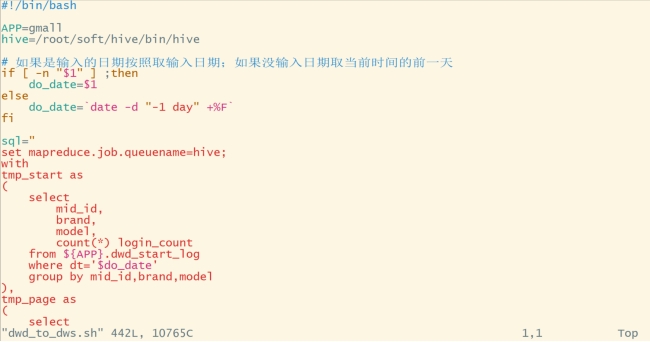
#赋权限:
chmod 777 dwd_to_dws.sh
#运行脚本加载数据:
dwd_to_dws.sh 2020-06-15查看导入数据:
select * from dws_area_stats_daycount where dt='2020-06-15' limit 2;
(7).建DWT层所有主题对象的累积行为表;


仅展示部分sql代码,创建DWT数据加载脚本:vim dws_to_dwt.sh
#!/bin/bash
APP=gmall
hive=/root/soft/hive/bin/hive
# 如果是输入的日期按照取输入日期;如果没输入日期取当前时间的前一天
if [ -n "$1" ] ;then
do_date=$1
else
do_date=`date -d "-1 day" +%F`
fi
sql="
set mapreduce.job.queuename=hive;
insert overwrite table ${APP}.dwt_uv_topic
select
nvl(new.mid_id,old.mid_id),
nvl(new.model,old.model),
nvl(new.brand,old.brand),
if(old.mid_id is null,'$do_date',old.login_date_first),
if(new.mid_id is not null,'$do_date',old.login_date_last),
if(new.mid_id is not null, new.login_count,0),
nvl(old.login_count,0)+if(new.login_count>0,1,0)
from
(
select
*
from ${APP}.dwt_uv_topic
)old
full outer join
(
select
*
from ${APP}.dws_uv_detail_daycount
where dt='$do_date'
)new
on old.mid_id=new.mid_id;
insert overwrite table ${APP}.dwt_user_topic
select
nvl(new.user_id,old.user_id),
if(old.login_date_first is null and new.login_count>0,'$do_date',old.login_date_first),
if(new.login_count>0,'$do_date',old.login_date_last),
nvl(old.login_count,0)+if(new.login_count>0,1,0),
nvl(new.login_last_30d_count,0),
if(old.order_date_first is null and new.order_count>0,'$do_date',old.order_date_first),
if(new.order_count>0,'$do_date',old.order_date_last),
nvl(old.order_count,0)+nvl(new.order_count,0),
nvl(old.order_amount,0)+nvl(new.order_amount,0),
nvl(new.order_last_30d_count,0),
nvl(new.order_last_30d_amount,0),
if(old.payment_date_first is null and new.payment_count>0,'$do_date',old.payment_date_first),
if(new.payment_count>0,'$do_date',old.payment_date_last),
nvl(old.payment_count,0)+nvl(new.payment_count,0),
nvl(old.payment_amount,0)+nvl(new.payment_amount,0),
nvl(new.payment_last_30d_count,0),
nvl(new.payment_last_30d_amount,0)
from
${APP}.dwt_user_topic old
full outer join
(
select
user_id,
sum(if(dt='$do_date',login_count,0)) login_count,
sum(if(dt='$do_date',order_count,0)) order_count,
sum(if(dt='$do_date',order_amount,0)) order_amount,
sum(if(dt='$do_date',payment_count,0)) payment_count,
sum(if(dt='$do_date',payment_amount,0)) payment_amount,
sum(if(login_count>0,1,0)) login_last_30d_count,
sum(order_count) order_last_30d_count,
sum(order_amount) order_last_30d_amount,
sum(payment_count) payment_last_30d_count,
sum(payment_amount) payment_last_30d_amount
from ${APP}.dws_user_action_daycount
where dt>=date_add( '$do_date',-30)
group by user_id
)new
on old.user_id=new.user_id;
insert overwrite table ${APP}.dwt_sku_topic
select
nvl(new.sku_id,old.sku_id),
sku_info.spu_id,
nvl(new.order_count30,0),
nvl(new.order_num30,0),
nvl(new.order_amount30,0),
nvl(old.order_count,0) + nvl(new.order_count,0),
nvl(old.order_num,0) + nvl(new.order_num,0),
nvl(old.order_amount,0) + nvl(new.order_amount,0),
nvl(new.payment_count30,0),
nvl(new.payment_num30,0),
nvl(new.payment_amount30,0),
nvl(old.payment_count,0) + nvl(new.payment_count,0),
nvl(old.payment_num,0) + nvl(new.payment_num,0),
nvl(old.payment_amount,0) + nvl(new.payment_amount,0),
nvl(new.refund_count30,0),
nvl(new.refund_num30,0),
nvl(new.refund_amount30,0),
nvl(old.refund_count,0) + nvl(new.refund_count,0),
nvl(old.refund_num,0) + nvl(new.refund_num,0),
nvl(old.refund_amount,0) + nvl(new.refund_amount,0),
nvl(new.cart_count30,0),
nvl(old.cart_count,0) + nvl(new.cart_count,0),
nvl(new.favor_count30,0),
nvl(old.favor_count,0) + nvl(new.favor_count,0),
nvl(new.appraise_good_count30,0),
nvl(new.appraise_mid_count30,0),
nvl(new.appraise_bad_count30,0),
nvl(new.appraise_default_count30,0) ,
nvl(old.appraise_good_count,0) + nvl(new.appraise_good_count,0),
nvl(old.appraise_mid_count,0) + nvl(new.appraise_mid_count,0),
nvl(old.appraise_bad_count,0) + nvl(new.appraise_bad_count,0),
nvl(old.appraise_default_count,0) + nvl(new.appraise_default_count,0)
from
(
select
sku_id,
spu_id,
order_last_30d_count,
order_last_30d_num,
order_last_30d_amount,
order_count,
order_num,
order_amount ,
payment_last_30d_count,
payment_last_30d_num,
payment_last_30d_amount,
payment_count,
payment_num,
payment_amount,
refund_last_30d_count,
refund_last_30d_num,
refund_last_30d_amount,
refund_count,
refund_num,
refund_amount,
cart_last_30d_count,
cart_count,
favor_last_30d_count,
favor_count,
appraise_last_30d_good_count,
appraise_last_30d_mid_count,
appraise_last_30d_bad_count,
appraise_last_30d_default_count,
appraise_good_count,
appraise_mid_count,
appraise_bad_count,
appraise_default_count
from ${APP}.dwt_sku_topic
)old
full outer join
(
select
sku_id,
sum(if(dt='$do_date', order_count,0 )) order_count,
sum(if(dt='$do_date',order_num ,0 )) order_num,
sum(if(dt='$do_date',order_amount,0 )) order_amount ,
sum(if(dt='$do_date',payment_count,0 )) payment_count,
sum(if(dt='$do_date',payment_num,0 )) payment_num,
sum(if(dt='$do_date',payment_amount,0 )) payment_amount,
sum(if(dt='$do_date',refund_count,0 )) refund_count,
sum(if(dt='$do_date',refund_num,0 )) refund_num,
sum(if(dt='$do_date',refund_amount,0 )) refund_amount,
sum(if(dt='$do_date',cart_count,0 )) cart_count,
sum(if(dt='$do_date',favor_count,0 )) favor_count,
sum(if(dt='$do_date',appraise_good_count,0 )) appraise_good_count,
sum(if(dt='$do_date',appraise_mid_count,0 ) ) appraise_mid_count ,
sum(if(dt='$do_date',appraise_bad_count,0 )) appraise_bad_count,
sum(if(dt='$do_date',appraise_default_count,0 )) appraise_default_count,
sum(order_count) order_count30 ,
sum(order_num) order_num30,
sum(order_amount) order_amount30,
sum(payment_count) payment_count30,
sum(payment_num) payment_num30,
sum(payment_amount) payment_amount30,
sum(refund_count) refund_count30,
sum(refund_num) refund_num30,
sum(refund_amount) refund_amount30,
sum(cart_count) cart_count30,
sum(favor_count) favor_count30,
sum(appraise_good_count) appraise_good_count30,
sum(appraise_mid_count) appraise_mid_count30,
sum(appraise_bad_count) appraise_bad_count30,
sum(appraise_default_count) appraise_default_count30
from ${APP}.dws_sku_action_daycount
where dt >= date_add ('$do_date', -30)
group by sku_id
)new
on new.sku_id = old.sku_id
left join
(select * from ${APP}.dwd_dim_sku_info where dt='$do_date') sku_info
on nvl(new.sku_id,old.sku_id)= sku_info.id;
insert overwrite table ${APP}.dwt_activity_topic
select
nvl(new.id,old.id),
nvl(new.activity_name,old.activity_name),
nvl(new.activity_type,old.activity_type),
nvl(new.start_time,old.start_time),
nvl(new.end_time,old.end_time),
nvl(new.create_time,old.create_time),
nvl(new.display_count,0),
nvl(new.order_count,0),
nvl(new.order_amount,0.0),
nvl(new.payment_count,0),
nvl(new.payment_amount,0.0),
nvl(new.display_count,0)+nvl(old.display_count,0),
nvl(new.order_count,0)+nvl(old.order_count,0),
nvl(new.order_amount,0.0)+nvl(old.order_amount,0.0),
nvl(new.payment_count,0)+nvl(old.payment_count,0),
nvl(new.payment_amount,0.0)+nvl(old.payment_amount,0.0)
from
(
select
*
from ${APP}.dwt_activity_topic
)old
full outer join
(
select
*
from ${APP}.dws_activity_info_daycount
where dt='$do_date'
)new
on old.id=new.id;
insert overwrite table ${APP}.dwt_area_topic
select
nvl(old.id,new.id),
nvl(old.province_name,new.province_name),
nvl(old.area_code,new.area_code),
nvl(old.iso_code,new.iso_code),
nvl(old.region_id,new.region_id),
nvl(old.region_name,new.region_name),
nvl(new.login_day_count,0),
nvl(new.login_last_30d_count,0),
nvl(new.order_day_count,0),
nvl(new.order_day_amount,0.0),
nvl(new.order_last_30d_count,0),
nvl(new.order_last_30d_amount,0.0),
nvl(new.payment_day_count,0),
nvl(new.payment_day_amount,0.0),
nvl(new.payment_last_30d_count,0),
nvl(new.payment_last_30d_amount,0.0)
from
(
select
*
from ${APP}.dwt_area_topic
)old
full outer join
(
select
id,
province_name,
area_code,
iso_code,
region_id,
region_name,
sum(if(dt='$do_date',login_count,0)) login_day_count,
sum(if(dt='$do_date',order_count,0)) order_day_count,
sum(if(dt='$do_date',order_amount,0.0)) order_day_amount,
sum(if(dt='$do_date',payment_count,0)) payment_day_count,
sum(if(dt='$do_date',payment_amount,0.0)) payment_day_amount,
sum(login_count) login_last_30d_count,
sum(order_count) order_last_30d_count,
sum(order_amount) order_last_30d_amount,
sum(payment_count) payment_last_30d_count,
sum(payment_amount) payment_last_30d_amount
from ${APP}.dws_area_stats_daycount
where dt>=date_add('$do_date',-30)
group by id,province_name,area_code,iso_code,region_id,region_name
)new
on old.id=new.id;
"
$hive -e "$sql"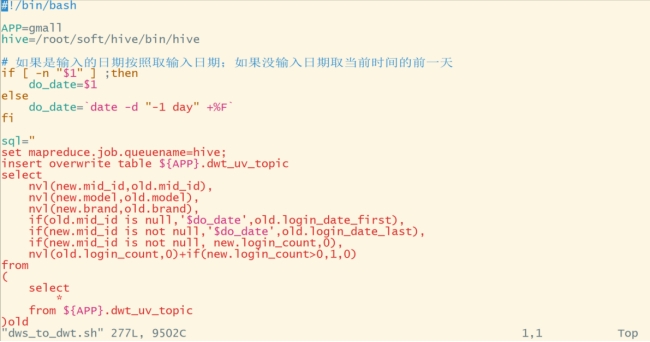
#赋权限:
chmod 777 dws_to_dwt.sh
#运行脚本加载数据:
dws_to_dwt.sh 2020-06-15查看导入数据:
select * from dwt_uv_topic limit 5;
(8).建ADS层所有主题指标分析表;


仅展示部分sql代码,创建ADS层数据加载脚本:vim dwt_to_ads.sh
#!/bin/bash
hive=/root/soft/hive/bin/hive
APP=gmall
# 如果是输入的日期按照取输入日期;如果没输入日期取当前时间的前一天
if [ -n "$1" ] ;then
do_date=$1
else
do_date=`date -d "-1 day" +%F`
fi
sql="
set mapreduce.job.queuename=hive;
insert into table ${APP}.ads_uv_count
select
'$do_date' dt,
daycount.ct,
wkcount.ct,
mncount.ct,
if(date_add(next_day('$do_date','MO'),-1)='$do_date','Y','N') ,
if(last_day('$do_date')='$do_date','Y','N')
from
(
select
'$do_date' dt,
count(*) ct
from ${APP}.dwt_uv_topic
where login_date_last='$do_date'
)daycount join
(
select
'$do_date' dt,
count (*) ct
from ${APP}.dwt_uv_topic
where login_date_last>=date_add(next_day('$do_date','MO'),-7)
and login_date_last<= date_add(next_day('$do_date','MO'),-1)
) wkcount on daycount.dt=wkcount.dt
join
(
select
'$do_date' dt,
count (*) ct
from ${APP}.dwt_uv_topic
where date_format(login_date_last,'yyyy-MM')=date_format('$do_date','yyyy-MM')
)mncount on daycount.dt=mncount.dt;
insert into table ${APP}.ads_new_mid_count
select
login_date_first,
count(*)
from ${APP}.dwt_uv_topic
where login_date_first='$do_date'
group by login_date_first;
insert into table ${APP}.ads_silent_count
select
'$do_date',
count(*)
from ${APP}.dwt_uv_topic
where login_date_first=login_date_last
and login_date_last<=date_add('$do_date',-7);
insert into table ${APP}.ads_back_count
select
'$do_date',
concat(date_add(next_day('$do_date','MO'),-7),'_', date_add(next_day('$do_date','MO'),-1)),
count(*)
from
(
select
mid_id
from ${APP}.dwt_uv_topic
where login_date_last>=date_add(next_day('$do_date','MO'),-7)
and login_date_last<= date_add(next_day('$do_date','MO'),-1)
and login_date_first<date_add(next_day('$do_date','MO'),-7)
)current_wk
left join
(
select
mid_id
from ${APP}.dws_uv_detail_daycount
where dt>=date_add(next_day('$do_date','MO'),-7*2)
and dt<= date_add(next_day('$do_date','MO'),-7-1)
group by mid_id
)last_wk
on current_wk.mid_id=last_wk.mid_id
where last_wk.mid_id is null;
insert into table ${APP}.ads_wastage_count
select
'$do_date',
count(*)
from
(
select
mid_id
from ${APP}.dwt_uv_topic
where login_date_last<=date_add('$do_date',-7)
group by mid_id
)t1;
insert into table ${APP}.ads_user_retention_day_rate
select
'$do_date',--统计日期
date_add('$do_date',-1),--新增日期
1,--留存天数
sum(if(login_date_first=date_add('$do_date',-1) and login_date_last='$do_date',1,0)),--$do_date的1日留存数
sum(if(login_date_first=date_add('$do_date',-1),1,0)),--$do_date新增
sum(if(login_date_first=date_add('$do_date',-1) and login_date_last='$do_date',1,0))/sum(if(login_date_first=date_add('$do_date',-1),1,0))*100
from ${APP}.dwt_uv_topic
union all
select
'$do_date',--统计日期
date_add('$do_date',-2),--新增日期
2,--留存天数
sum(if(login_date_first=date_add('$do_date',-2) and login_date_last='$do_date',1,0)),--$do_date的2日留存数
sum(if(login_date_first=date_add('$do_date',-2),1,0)),--$do_date新增
sum(if(login_date_first=date_add('$do_date',-2) and login_date_last='$do_date',1,0))/sum(if(login_date_first=date_add('$do_date',-2),1,0))*100
from ${APP}.dwt_uv_topic
union all
select
'$do_date',--统计日期
date_add('$do_date',-3),--新增日期
3,--留存天数
sum(if(login_date_first=date_add('$do_date',-3) and login_date_last='$do_date',1,0)),--$do_date的3日留存数
sum(if(login_date_first=date_add('$do_date',-3),1,0)),--$do_date新增
sum(if(login_date_first=date_add('$do_date',-3) and login_date_last='$do_date',1,0))/sum(if(login_date_first=date_add('$do_date',-3),1,0))*100
from ${APP}.dwt_uv_topic;
insert into table ${APP}.ads_continuity_wk_count
select
'$do_date',
concat(date_add(next_day('$do_date','MO'),-7*3),'_',date_add(next_day('$do_date','MO'),-1)),
count(*)
from
(
select
mid_id
from
(
select
mid_id
from ${APP}.dws_uv_detail_daycount
where dt>=date_add(next_day('$do_date','monday'),-7)
and dt<=date_add(next_day('$do_date','monday'),-1)
group by mid_id
union all
select
mid_id
from ${APP}.dws_uv_detail_daycount
where dt>=date_add(next_day('$do_date','monday'),-7*2)
and dt<=date_add(next_day('$do_date','monday'),-7-1)
group by mid_id
union all
select
mid_id
from ${APP}.dws_uv_detail_daycount
where dt>=date_add(next_day('$do_date','monday'),-7*3)
and dt<=date_add(next_day('$do_date','monday'),-7*2-1)
group by mid_id
)t1
group by mid_id
having count(*)=3
)t2;
insert into table ${APP}.ads_continuity_uv_count
select
'$do_date',
concat(date_add('$do_date',-6),'_','$do_date'),
count(*)
from
(
select mid_id
from
(
select mid_id
from
(
select
mid_id,
date_sub(dt,rank) date_dif
from
(
select
mid_id,
dt,
rank() over(partition by mid_id order by dt) rank
from ${APP}.dws_uv_detail_daycount
where dt>=date_add('$do_date',-6) and dt<='$do_date'
)t1
)t2
group by mid_id,date_dif
having count(*)>=3
)t3
group by mid_id
)t4;
insert into table ${APP}.ads_user_topic
select
'$do_date',
sum(if(login_date_last='$do_date',1,0)),
sum(if(login_date_first='$do_date',1,0)),
sum(if(payment_date_first='$do_date',1,0)),
sum(if(payment_count>0,1,0)),
count(*),
sum(if(login_date_last='$do_date',1,0))/count(*),
sum(if(payment_count>0,1,0))/count(*),
sum(if(login_date_first='$do_date',1,0))/sum(if(login_date_last='$do_date',1,0))
from ${APP}.dwt_user_topic;
with
tmp_uv as
(
select
'$do_date' dt,
sum(if(array_contains(pages,'home'),1,0)) home_count,
sum(if(array_contains(pages,'good_detail'),1,0)) good_detail_count
from
(
select
mid_id,
collect_set(page_id) pages
from ${APP}.dwd_page_log
where dt='$do_date'
and page_id in ('home','good_detail')
group by mid_id
)tmp
),
tmp_cop as
(
select
'$do_date' dt,
sum(if(cart_count>0,1,0)) cart_count,
sum(if(order_count>0,1,0)) order_count,
sum(if(payment_count>0,1,0)) payment_count
from ${APP}.dws_user_action_daycount
where dt='$do_date'
)
insert into table ${APP}.ads_user_action_convert_day
select
tmp_uv.dt,
tmp_uv.home_count,
tmp_uv.good_detail_count,
tmp_uv.good_detail_count/tmp_uv.home_count*100,
tmp_cop.cart_count,
tmp_cop.cart_count/tmp_uv.good_detail_count*100,
tmp_cop.order_count,
tmp_cop.order_count/tmp_cop.cart_count*100,
tmp_cop.payment_count,
tmp_cop.payment_count/tmp_cop.order_count*100
from tmp_uv
join tmp_cop
on tmp_uv.dt=tmp_cop.dt;
insert into table ${APP}.ads_product_info
select
'$do_date' dt,
sku_num,
spu_num
from
(
select
'$do_date' dt,
count(*) sku_num
from
${APP}.dwt_sku_topic
) tmp_sku_num
join
(
select
'$do_date' dt,
count(*) spu_num
from
(
select
spu_id
from
${APP}.dwt_sku_topic
group by
spu_id
) tmp_spu_id
) tmp_spu_num
on
tmp_sku_num.dt=tmp_spu_num.dt;
insert into table ${APP}.ads_product_sale_topN
select
'$do_date' dt,
sku_id,
payment_amount
from
${APP}.dws_sku_action_daycount
where
dt='$do_date'
order by payment_amount desc
limit 10;
insert into table ${APP}.ads_product_favor_topN
select
'$do_date' dt,
sku_id,
favor_count
from
${APP}.dws_sku_action_daycount
where
dt='$do_date'
order by favor_count desc
limit 10;
insert into table ${APP}.ads_product_cart_topN
select
'$do_date' dt,
sku_id,
cart_count
from
${APP}.dws_sku_action_daycount
where
dt='$do_date'
order by cart_count desc
limit 10;
insert into table ${APP}.ads_product_refund_topN
select
'$do_date',
sku_id,
refund_last_30d_count/payment_last_30d_count*100 refund_ratio
from ${APP}.dwt_sku_topic
order by refund_ratio desc
limit 10;
insert into table ${APP}.ads_appraise_bad_topN
select
'$do_date' dt,
sku_id,
appraise_bad_count/(appraise_good_count+appraise_mid_count+appraise_bad_count+appraise_default_count) appraise_bad_ratio
from
${APP}.dws_sku_action_daycount
where
dt='$do_date'
order by appraise_bad_ratio desc
limit 10;
insert into table ${APP}.ads_order_daycount
select
'$do_date',
sum(order_count),
sum(order_amount),
sum(if(order_count>0,1,0))
from ${APP}.dws_user_action_daycount
where dt='$do_date';
insert into table ${APP}.ads_payment_daycount
select
tmp_payment.dt,
tmp_payment.payment_count,
tmp_payment.payment_amount,
tmp_payment.payment_user_count,
tmp_skucount.payment_sku_count,
tmp_time.payment_avg_time
from
(
select
'$do_date' dt,
sum(payment_count) payment_count,
sum(payment_amount) payment_amount,
sum(if(payment_count>0,1,0)) payment_user_count
from ${APP}.dws_user_action_daycount
where dt='$do_date'
)tmp_payment
join
(
select
'$do_date' dt,
sum(if(payment_count>0,1,0)) payment_sku_count
from ${APP}.dws_sku_action_daycount
where dt='$do_date'
)tmp_skucount on tmp_payment.dt=tmp_skucount.dt
join
(
select
'$do_date' dt,
sum(unix_timestamp(payment_time)-unix_timestamp(create_time))/count(*)/60 payment_avg_time
from ${APP}.dwd_fact_order_info
where dt='$do_date'
and payment_time is not null
)tmp_time on tmp_payment.dt=tmp_time.dt;
with
tmp_order as
(
select
user_id,
order_stats_struct.sku_id sku_id,
order_stats_struct.order_count order_count
from ${APP}.dws_user_action_daycount lateral view explode(order_detail_stats) tmp as order_stats_struct
where date_format(dt,'yyyy-MM')=date_format('$do_date','yyyy-MM')
),
tmp_sku as
(
select
id,
tm_id,
category1_id,
category1_name
from ${APP}.dwd_dim_sku_info
where dt='$do_date'
)
insert into table ${APP}.ads_sale_tm_category1_stat_mn
select
tm_id,
category1_id,
category1_name,
sum(if(order_count>=1,1,0)) buycount,
sum(if(order_count>=2,1,0)) buyTwiceLast,
sum(if(order_count>=2,1,0))/sum( if(order_count>=1,1,0)) buyTwiceLastRatio,
sum(if(order_count>=3,1,0)) buy3timeLast ,
sum(if(order_count>=3,1,0))/sum( if(order_count>=1,1,0)) buy3timeLastRatio ,
date_format('$do_date' ,'yyyy-MM') stat_mn,
'$do_date' stat_date
from
(
select
tmp_order.user_id,
tmp_sku.category1_id,
tmp_sku.category1_name,
tmp_sku.tm_id,
sum(order_count) order_count
from tmp_order
join tmp_sku
on tmp_order.sku_id=tmp_sku.id
group by tmp_order.user_id,tmp_sku.category1_id,tmp_sku.category1_name,tmp_sku.tm_id
)tmp
group by tm_id, category1_id, category1_name;
insert into table ${APP}.ads_area_topic
select
'$do_date',
id,
province_name,
area_code,
iso_code,
region_id,
region_name,
login_day_count,
order_day_count,
order_day_amount,
payment_day_count,
payment_day_amount
from ${APP}.dwt_area_topic;
"
$hive -e "$sql"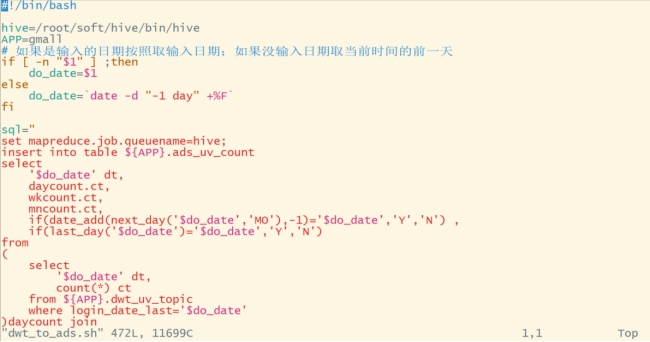
# 赋权限:
chmod 777 dwt_to_ads.sh
#运行脚本导入数据:
dwt_to_ads.sh 2020-06-15查看是否成功导入数据:
select * from ads_area_topic where dt='2020-06-15'; 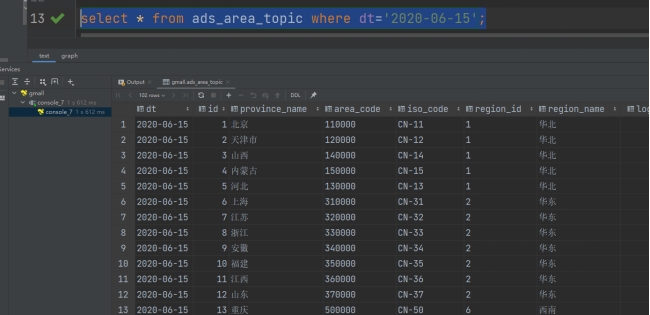
(9).Azkaban调度;
安装Azkaban,上传安装包:

创建azkaban文件夹:mkdir /root/soft/azkaban
解压:
tar -zxvf azkaban-exec-server-3.84.4.tar.gz -C /root/soft/azkaban
tar -zxvf azkaban-web-server-3.84.4.tar.gz -C /root/soft/azkaban
tar -zxvf azkaban-db-3.84.4.tar.gz -C /root/soft/azkaban打开Navicat连接hadoop1的MySQL,创建azkaban数据库:


输入:
CREATE USER 'azkaban'@'%' IDENTIFIED BY '000000';
GRANT SELECT,INSERT,UPDATE,DELETE ON azkaban.* to 'azkaban'@'%' WITH GRANT OPTION;本地解压azkaban-db-3.84.4.tar.gz,导入sql代码:

更改MySQL包的大小,防止Azkaban连接MySQL阻塞:sudo vim /etc/my.cnf
在[mysqld]下面加一行:max_allowed_packet=1024M
重启MySQL:sudo systemctl restart mysqld
如果是基于docker安装的MySQL,先启动docker服务:service docker start
查看历史容器:docker ps -a

#重启MySQL容器:
docker restart 容器id
#进入容器使用MySQL:
docker exec -it 容器id /bin/bash
#输入MySQL启动命令:
mysql -uroot -p123456
一般情况下,容器内没有vim
# 先更新我们的包管理工具
apt-get update
# 然后安装我们需要的vim
apt-get install vim切换到Mysql目录下,编辑mysql.conf.d:
vim /etc/mysql/mysql.conf.d
在[mysqld]下面加一行:max_allowed_packet=1024M

退出容器:exit
重启容器:docker restart 容器id
切换目录:cd /root/soft/azkaban/
创建软连接:
ln -s azkaban-exec-server-3.84.4 azkaban-exec
ln -s azkaban-web-server-3.84.4 azkaban-web
ln -s azkaban-db-3.84.4 azkaban-db
修改azkaban-exec/conf目录下的azkaban.properties:
vim azkaban-exec/conf/azkaban.properties修改如下内容:
default.timezone.id=Asia/Shanghai
azkaban.webserver.url=http://hadoop1:8081
mysql.host=hadoop1
mysql.password=000000在最后一行添加:
executor.port=12321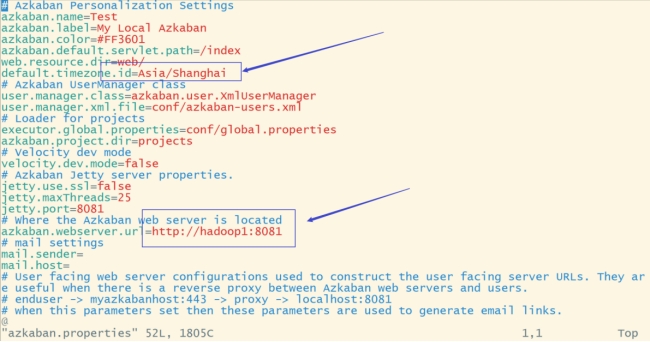

进入azkaban目录分发azkaban-exec:xsync azkaban-exec-server-3.84.4
hadoop1,hadoop2,hadoop3进入azkaban-exec-server-3.84.4目录,启动executor:bin/start-exec.sh
在第一台依次激活executor:
curl -G "hadoop1:12321/executor?action=activate" && echo
curl -G "hadoop2:12321/executor?action=activate" && echo
curl -G "hadoop3:12321/executor?action=activate" && echo
配置azkaban-web,进入azkaban-web/conf目录,编辑azkaban.properties:
vim /root/soft/azkaban/azkaban-web/conf/azkaban.properties修改如下内容:
default.timezone.id=Asia/Shanghai
mysql.host=hadoop1
mysql.password=000000
azkaban.executorselector.filters=StaticRemainingFlowSize,CpuStatus

编辑azkaban-user.xml:
vim /root/soft/azkaban/azkaban-web/conf/azkaban-users.xml添加hadoop用户及密码,用于web登录:
<user password="root" roles="admin" username="root"/>
进入azkaban-web目录,启动web server:bin/start-web.sh
在网页输入hadoop1:8081 (如果本地没有映射,就输入hadoop1的ip地址)
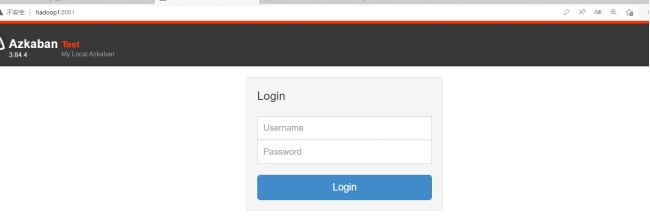
修改/root/soft/applog/application.properties
vim /root/soft/applog/application.properties将日期修改成2020-06-26

然后分发: xsync application.properties
创建MySQL数据库和表:



编写Sqoop导出脚本:vim hdfs_to_mysql.sh
#!/bin/bash
hive_db_name=gmall
mysql_db_name=gmall_report
export_data() {
/root/soft/sqoop/bin/sqoop export \
-Dmapreduce.job.queuename=hive \
--connect "jdbc:mysql://hadoop1:3306/${mysql_db_name}?useUnicode=true&characterEncoding=utf-8" \
--username root \
--password 123456 \
--table $1 \
--num-mappers 1 \
--export-dir /warehouse/$hive_db_name/ads/$1 \
--input-fields-terminated-by "\t" \
--update-mode allowinsert \
--update-key $2 \
--input-null-string '\\N' \
--input-null-non-string '\\N'
}
case $1 in
"ads_uv_count")
export_data "ads_uv_count" "dt"
;;
"ads_user_action_convert_day")
export_data "ads_user_action_convert_day" "dt"
;;
"ads_user_topic")
export_data "ads_user_topic" "dt"
;;
"ads_area_topic")
export_data "ads_area_topic" "dt,iso_code"
;;
"all")
export_data "ads_uv_count" "dt"
export_data "ads_user_topic" "dt"
export_data "ads_area_topic" "dt,iso_code"
#其余表省略未写
;;
esac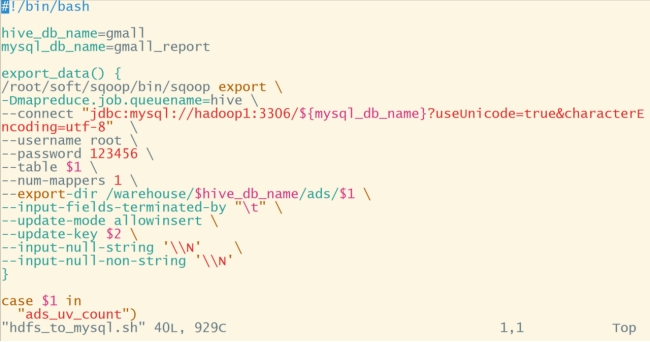
#赋权限:
chmod 777 hdfs_to_mysql.shSqoop导出数据:hdfs_to_mysql.sh all
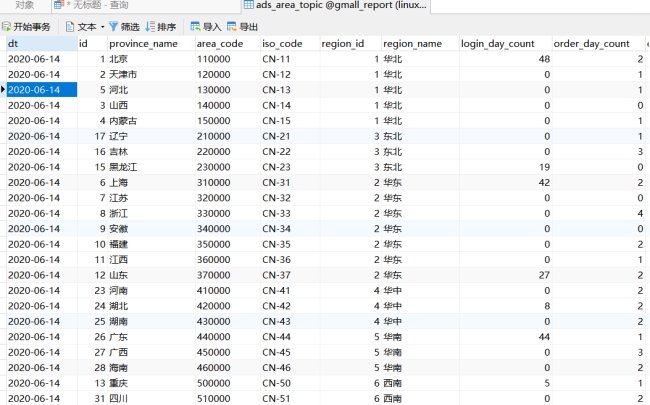
编写Azkaban工作流程配置文件;


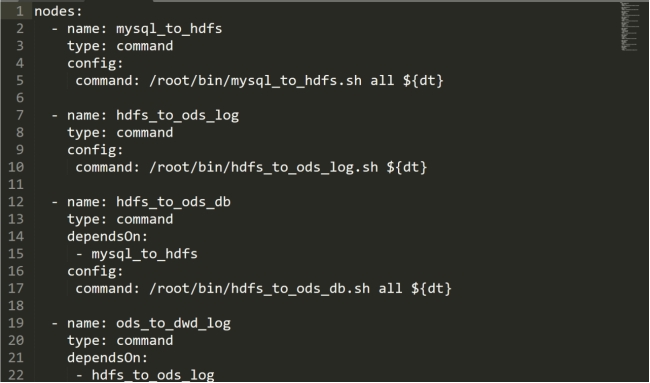
打包zip上传azkaban,创建gmall项目导入zip包:



执行以下命令
use azkaban;
SELECT * FROM executors;
第一个 dt 2020-06-26
第二个 useExecutor 1
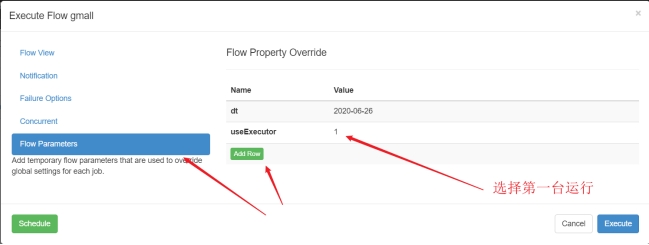

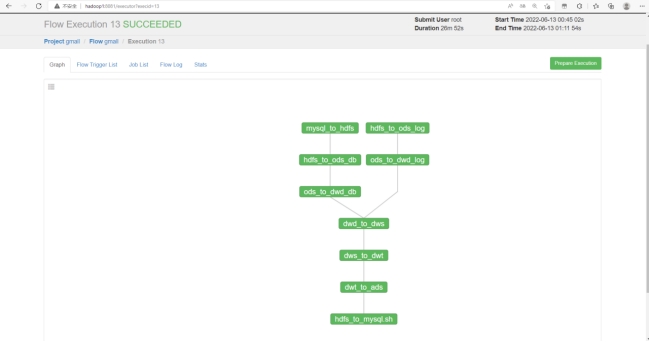
4.可视化报表。
(1).Superset入门;
安装Miniconda,上传安装包:
安装命令:
bash Miniconda3-latest-Linux-x86_64.sh
一直按回车,直到出现下面输入yes:

输入安装路径:

安装完成后,加载环境变量,使之生效: source ~/.bashrc

取消自动激活base环境:
conda config --set auto_activate_base false激活base环境:conda activate base

配置conda国内镜像:
conda config --add channels https://mirrors.tuna.tsinghua.edu.cn/anaconda/pkgs/free
conda config --add channels https://mirrors.tuna.tsinghua.edu.cn/anaconda/pkgs/main
conda config --set show_channel_urls yes查看conda的镜像配置:vim ~/.condarc

创建Python3.6环境:
conda create --name superset python=3.6查看所有环境:
conda info --envs选做:删除一个环境:
conda remove -n env_name --all激活superset环境:
conda activate superset执行python命令,查看Python版本:python
退出当前环境:
conda deactivate部署Superset,安装依赖;
sudo yum install -y gcc gcc-c++ libffi-devel python-devel python-pip python-wheel python-setuptools openssl-devel cyrus-sasl-devel openldap-devel安装(更新)setuptools和pip:
pip install --upgrade setuptools pip -i https://repo.huaweicloud.com/repository/pypi/simple安装Superset:
pip install apache-superset --trusted-host https://repo.huaweicloud.com -i https://repo.huaweicloud.com/repository/pypi/simple执行以下两条指令,否则无法初始化:
pip install sqlalchemy==1.3.24 -i https://repo.huaweicloud.com/repository/pypi/simple
pip install dataclasses -i https://repo.huaweicloud.com/repository/pypi/simple初始化Superset数据库:
superset db upgrade创建管理员用户,自己设置:
export FLASK_APP=superset
superset fab create-adminSuperset初始化:
superset init安装gunicorn:
pip install gunicorn -i https://repo.huaweicloud.com/repository/pypi/simple在superset环境下启动Superset:
gunicorn --workers 5 --timeout 120 --bind hadoop1:8787 "superset.app:create_app()" --daemon网页端访问hadoop1:8787:
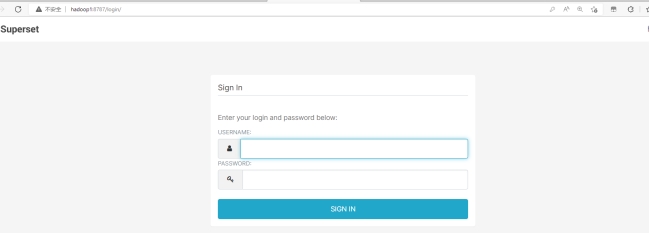
停止superset:
ps -ef | awk '/superset/ && !/awk/{print $2}' | xargs kill -9(2).superset启停脚本;
在/root/bin目录下:vim superset.sh
#!/bin/bash
superset_status(){
result=`ps -ef | awk '/gunicorn/ && !/awk/{print $2}' | wc -l`
if [[ $result -eq 0 ]]; then
return 0
else
return 1
fi
}
superset_start(){
# 该段内容取自~/.bashrc,所用是进行conda初始化
# >>> conda initialize >>>
# !! Contents within this block are managed by 'conda init' !!
__conda_setup="$('/root/soft/miniconda3/anconda3/bin/conda' 'shell.bash' 'hook' 2> /dev/null)"
if [ $? -eq 0 ]; then
eval "$__conda_setup"
else
if [ -f "/root/soft/miniconda3/anconda3/profile.d/conda.sh" ]; then
. "/root/soft/miniconda3/anconda3/etc/profile.d/conda.sh"
else
export PATH="/root/soft/miniconda3/anconda3/bin:$PATH"
fi
fi
unset __conda_setup
# <<< conda initialize <<<
superset_status >/dev/null 2>&1
if [[ $? -eq 0 ]]; then
conda activate superset ; gunicorn --workers 5 --timeout 120 --bind hadoop1:8787 --daemon 'superset.app:create_app()'
else
echo "superset正在运行"
fi
}
superset_stop(){
superset_status >/dev/null 2>&1
if [[ $? -eq 0 ]]; then
echo "superset未在运行"
else
ps -ef | awk '/gunicorn/ && !/awk/{print $2}' | xargs kill -9
fi
}
case $1 in
start )
echo "启动Superset"
superset_start
;;
stop )
echo "停止Superset"
superset_stop
;;
restart )
echo "重启Superset"
superset_stop
superset_start
;;
status )
superset_status >/dev/null 2>&1
if [[ $? -eq 0 ]]; then
echo "superset未在运行"
else
echo "superset正在运行"
fi
esac
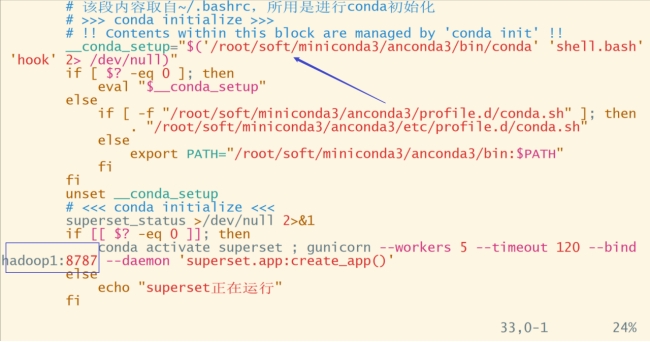
#赋权限:
chmod 777 superset.sh
#启动superset:
superset.sh start(3).Superset的使用;
#对接MySQL数据源,安装依赖:
conda install mysqlclient -y
#重启Superset:
superset.sh restart配置数据库:


mysql://root:123456@hadoop1/gmall_report?charset=utf8


表示连接成功,保存配置;
配置表:



(4).制作可视化数据;


